Jobs & Employment

Differences Between H-1B and OPT Visas Explained
Clients want roles filled. But visa questions? They slow everything down.
You’ve found a great candidate: skilled, available, ready to go. But then comes the paperwork. Are they on OPT? Do they need H-1B sponsorship? What’s the risk of them dropping out mid-process? It’s not just frustrating, it puts client relationships and revenue on the line.
Understanding the difference between H-1B and OPT isn’t a nice-to-have anymore. It’s essential. Especially when you consider in the past year, 65% of H-1B approvals were for renewals, while only 35% just over 141,000 were new applications for initial employment. That means the window for fresh H-1B hires is tighter than ever.
As a hiring manager, knowing how these visas work and how to plan around them can be the difference between a smooth placement and a last-minute scramble.
Let’s start with the foundations.
Understanding OPT
There’s always that early-career candidate who looks perfect until the visa question comes up.
Is their OPT valid? Can they actually start? Will they need sponsorship in six months?
Here’s what you need to know to make confident hiring decisions and reduce last-minute surprises.
Who Qualifies for OPT?
OPT (Optional Practical Training) is available to international students on F-1 visas.
It allows them to gain real-world experience in their field of study.
Key eligibility points:
- Must have completed at least one academic year in the U.S.
- Employment must be directly related to their major.
- Can apply during or after their degree program.
How Long Can They Work?
For most, OPT offers 12 months of work authorization.
But STEM graduates (science, tech, engineering, math) can apply for a 24-month extension.
So in total, a STEM OPT candidate can work up to 36 months post-graduation.
The Application Process
Timing is everything especially when roles need to be filled fast.
Students must:
- Apply through their university’s international student office.
- File Form I-765 with USCIS.
- Wait for the Employment Authorization Document (EAD) to start working.
Processing can take 2–3 months. So forward-planning is crucial.
What’s Required of You?
OPT candidates don’t need sponsorship, but that doesn’t mean there’s zero responsibility.
Responsibilities include:
- Job Alignment
Ensure the job aligns with the student’s major. - STEM Extension (Form I-983)
Sign off on training plans for STEM OPT extensions. - Track & Report Changes
Monitor and report any changes in job duties or work location. - Career Evolution
Recognize that OPT may be a stepping stone to an H-1B visa.
OPT is often the first step in a longer career journey, one that might evolve into an H-1B.
Consultadd supports hiring partners by providing candidates whose documentation, training plan readiness, and work status are fully managed—cutting down the time spent on compliance follow-ups and admin checklists.
OPT at a Glance: Advantages and Disadvantages
Let’s make it simple. Hiring someone on OPT has its perks and also a few things to watch out for. Here’s a quick side-by-side to help you weigh the benefits and potential challenges:
Hiring international talent with OPT status can open up a fast-moving talent pipeline, if done right. Learn how top companies accelerate onboarding and minimize delays in our blog: Efficient Tech Hiring Strategies for Fast Talent Acquisition
Note: While OPT candidates don’t need sponsorship, understanding these responsibilities ensures smoother transitions and future hiring opportunities.
Understanding the H-1B Visa
You're trying to fill a high-demand tech role, and the perfect candidate is ready to start.
But there's one big question: do they have H-1B status, or will they need sponsorship?
Understanding how the H-1B visa works can help you act quickly and minimize hiring delays.
What Is the H-1B Visa?
The H-1B is a temporary work visa for professionals in specialty occupations.
It allows companies to hire foreign talent with specific, high-level skills.
Most roles require:
- A bachelor’s degree or equivalent work experience.
- A job offer in a field that requires specialized knowledge (like tech, finance, or engineering).
Employer-Driven Process
Unlike the OPT process, the H-1B process is employer-sponsored, meaning your client must file the petition.
Here’s how it works:
- Employer submits an H-1B petition to USCIS.
- If selected in the cap, USCIS reviews and may approve it.
- Candidate receives H-1B status and start date approval.
This process can take several months, so early planning is essential.
Cap Limits and the Lottery
The H-1B program is capped at 85,000 visas annually:
Due to high demand, most applications go through a lottery.
That means even qualified candidates might not be selected.
Duration and Extensions
The initial H-1B term is three years. It can be extended up to six years total.
In some cases, extensions beyond six years are possible if green card steps are underway.
Unlike OPT, H-1B requires a deeper commitment and more coordination.
But for long-term roles, it’s often the path to retention and career growth.
The H-1B Route: Advantages and Disadvantages
OPT might get someone in the door fast, but H-1B is often the better option for long-term hiring. Still, it’s not without its paperwork, timing issues, and cost. Here's a quick snapshot to help understand:
Transitions from OPT to H-1B
Therefore, visa transitions aren’t just admin work; it's a bold change reshaping the future.
Planning the transition to H-1B early gives staffing partners more control and peace of mind.
Why This Transition Matters
- Many talented international candidates start on OPT.
- Without H-1B transition, they risk falling out of status.
- Recruiters may lose great talent just due to poor planning.
How does the Transition work?
1. Use OPT as a Stepping Stone
OPT gives candidates 12–36 months of work experience.
Use this time to assess fit, train well, and plan forward.
2. Time the H-1B Filing Right
H-1B petitions are filed in March, with results in April.
Start prepping months in advance; February is already cutting it close.
3. Cap-Gap Extension Can Help
If filed on time, candidates can stay employed while waiting for H-1B approval.
This bridges the gap between OPT expiration and H-1B start in October.
Here are key points to make a note of when facilitating a transition from OPT to H1-B:
Therefore, handled well, this transition creates retention, trust, and long-term hiring success.
The STEM OPT Extension
For candidates with STEM degrees (Science, Technology, Engineering, Math), OPT isn’t just 12 months, it can stretch to 36 months, thanks to the 24-month STEM OPT Extension.
This extension gives recruiters and employers a longer runway to evaluate fit, file for H-1B, and build a sponsorship plan across multiple cycles.
To qualify:
- Degree must be listed on DHS’s STEM-designated list.
- Employer must be E-Verified.
- Role must directly relate to the field of study.
Here’s a quick breakdown:
Steps for Securing H-1B Post-OPT
Hiring managers know the pain of seeing a great candidate slip through the cracks.
Especially when the only thing standing in the way is a missed deadline or documentation error.
Securing an H-1B after OPT isn't just about paperwork; it's about protecting talent you’ve invested in.
With Consultadd, you get candidates whose work authorization and documentation are fully managed, reducing onboarding delays and last-minute surprises.
Proactive planning keeps your top candidates working, not waiting.
Legal Considerations
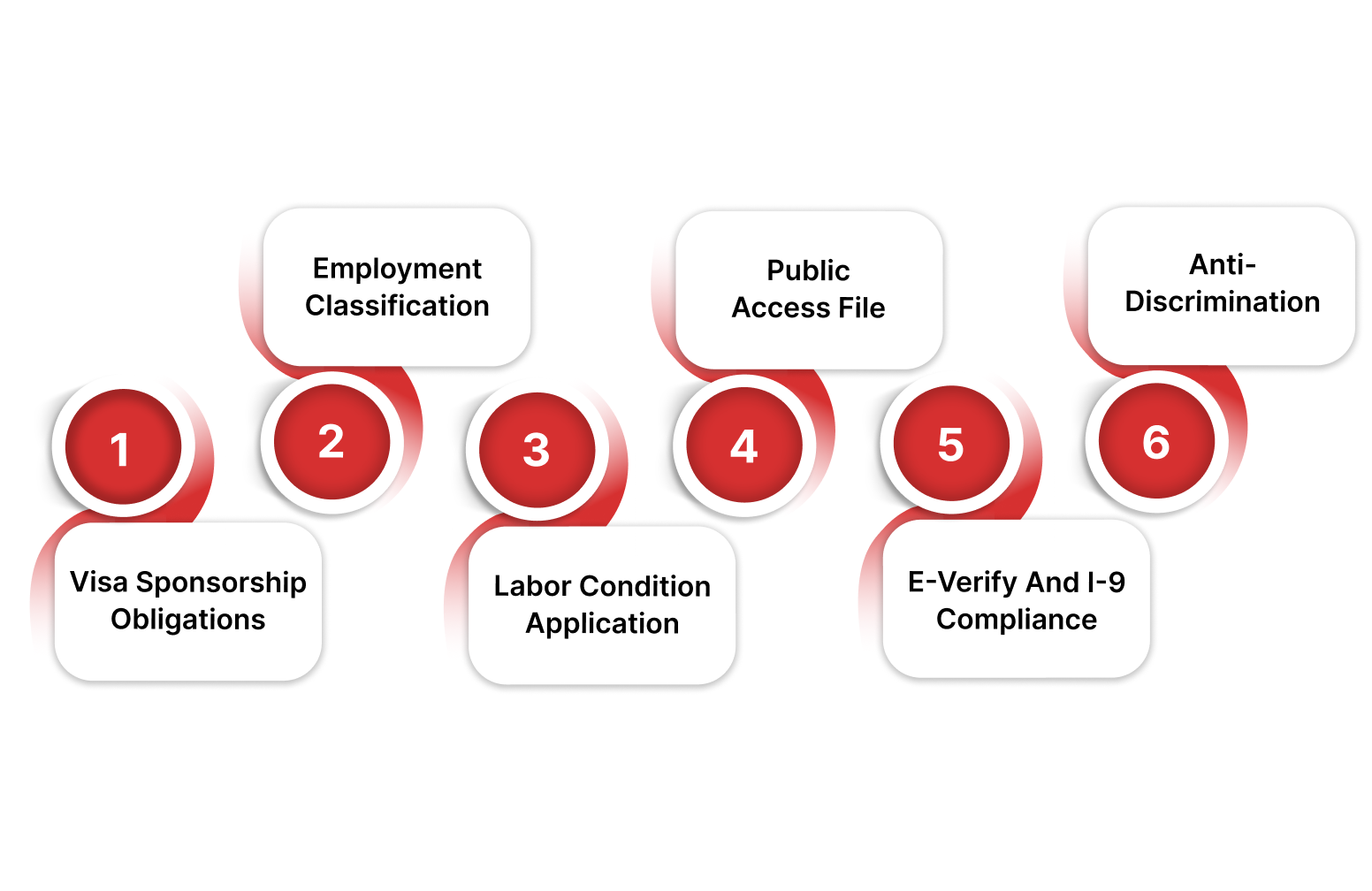
Hiring international talent brings big rewards, but it also means playing by the rules.
For hiring managers, compliance isn’t optional. It’s the difference between growth and costly setbacks.
Let’s understand the key legal boxes to check, before they become blind spots.
1. Visa Sponsorship Obligations
- Employers must prove the job aligns with the candidate’s field of study.
- You must pay at or above the prevailing wage for the job location and role.
2. Employment Classification
- Don’t misclassify employees. It impacts taxes, benefits, and compliance audits.
- Know the difference between W2 and C2C, it matters for visa-holding workers.
3. LCA (Labor Condition Application)
- File an LCA with the Department of Labor before submitting the H-1B petition.
- The LCA verifies pay rates and affirms that hiring won't hurt U.S. workers.
4. Public Access File (PAF)
- Keep a file for each H-1B worker, ready for DOL inspection.
- Include wage details, notices, and LCA copies, it must be accessible within one business day.
5. E-Verify and I-9 Compliance
- Every new hire, visa holder or not, must complete Form I-9.
- E-Verify isn’t mandatory everywhere, but it’s smart for staying ahead of audits.
6. Anti-Discrimination Rules
- You can’t ask about immigration status during early recruitment.
- Focus on work authorization eligibility instead of visa type in interviews.
One slip in legal compliance can undo months of effort.
Benefits of Each Visa Type
Visa types aren’t just paperwork, they're powerful tools for building agile, future-ready teams.
Understanding the strengths of each visa helps recruiters make faster, smarter hiring decisions.
Let’s look at how OPT and H-1B each bring unique advantages to the table.
OPT (Optional Practical Training)
A smart entry point for companies seeking fresh energy and tech-aligned skill sets.
Why hiring managers love OPT talent:
- No immediate sponsorship required, less friction, faster onboarding.
- Candidates often bring the latest tools, frameworks, and thinking from U.S. universities.
- Ideal for short-term roles or testing long-term fit before filing H-1B.
- OPT STEM extension gives an extra 24 months, more time, more planning power.
H-1B (Specialty Occupation Visa)
Built for long-term value and hard-to-find expertise.
H-1B perks hiring managers can rely on:
- Candidates can stay up to 6 years, perfect for stable, strategic placements.
- Covers a wide range of roles, engineering, finance, healthcare, and IT.
- Enables deep client trust through consistent workforce planning.
- Adds credibility to staffing firms with strong visa sponsorship systems.
Understanding visa types is just one part of the strategic talent equation. It’s how smart talent mapping bridges skills gaps and powers long-term growth. Read our blog: From Skills Gap to Strategic Growth: Talent Mapping That Delivers, to learn more.
Conclusion: Maximizing Career Opportunities through OPT and H-1B Visas
As hiring managers, you're racing against time, demand is high, stakes are higher, and mistakes are expensive.
Visa transitions can’t be a trial and error. They need precision, speed, and staying power.
OPT and H-1B aren't just visa types; they're tools to build long-term, compliant, high-performing teams.
That’s where Consultadd changes the game. We ensure you truly understand both options, helping you place faster, smarter, and with greater confidence.
We help you with:
- Safe, reliable hires: Every candidate is thoroughly vetted for experience and compliance.
- Lower turnover risks: We send professionals committed to long-term growth, not just short-term stints.
- Seamless compliance: We handle visa paperwork, documentation, and updates, so you don’t have to.
- Continuous support: Even post-placement, we stay engaged to ensure candidate success.
And the numbers back it:
- 5,000+ successful staffing engagements
- 65+ satisfied staffing companies in the last year
- Top 100 candidates provided in the last year alone
- MSAs signed with top firms like Robert Half and Teksystems
- Talent sourced in under 24 hours
- Ready-to-deploy candidates with university-backed training
- One-on-one account managers focused on your success
- 14+ years of deep industry expertise
Consultadd doesn’t just supply talent; we power your hiring engine.
If you're ready to remove friction, scale faster, and stay compliant, we’re ready to help. Book a call with us today and experience hiring that delivers from day one.

Corp to Corp Visa Sponsorship Explained for H1B Jobs
TL;DR:
- C2C Sponsorship for H1B Jobs helps staffing agencies fill roles faster with less paperwork.
- Access to Pre-Vetted H1B Candidates ensures quick placements with qualified professionals.
- Ensures Compliance with Visa Regulations by managing all the legal paperwork and requirements.
- Reduces Administrative Burden by streamlining the hiring process and reducing paperwork for both agencies and clients.
- Streamlines the Hiring Process, making it easier for staffing agencies to place candidates efficiently.
As a recruiter or staffing professional, we know you're no stranger to the pressure of finding the right talent, especially when it comes to H1B visa jobs.
The stakes are high, the deadlines are tight, and the paperwork can feel like a mountain.
But what if there was a way to make the whole process smoother, faster, and more efficient?
Enter Corp to Corp (C2C) visa sponsorship. This method allows you to bypass a lot of the typical hurdles, helping you connect the best H1B candidates with your clients quickly and compliantly.
Ready to dive in and discover how C2C can simplify your recruitment process for H1B talent? Let’s break it down!
Understanding Corp to Corp (C2C) Visa Sponsorship
When it comes to hiring H1B candidates, staffing agencies often face the challenge of managing visa processes, compliance, and delays. That's where Corp to Corp (C2C) visa sponsorship can make all the difference.
It's a game-changing solution for connecting top talent with businesses in need, while keeping things efficient and compliant.
What is Corp to Corp (C2C) Sponsorship?
Corp to Corp sponsorship is an arrangement where a staffing agency or employer contracts a candidate through their corporation.
This means the worker is not hired directly by the client but works under the agency's or a third party’s employment.
Difference from Other Visa Types:
- Unlike traditional H1B sponsorship, where the employer directly sponsors the candidate, C2C allows for more flexibility.
- The worker is technically employed by the staffing agency or a third-party corporation, not the end client.
In short, C2C allows agencies to simplify hiring processes, keep compliance intact, and fill H1B roles faster.
It’s a win-win for both staffing agencies and clients who need skilled workers quickly.
How Does C2C Work for Staffing Agencies?
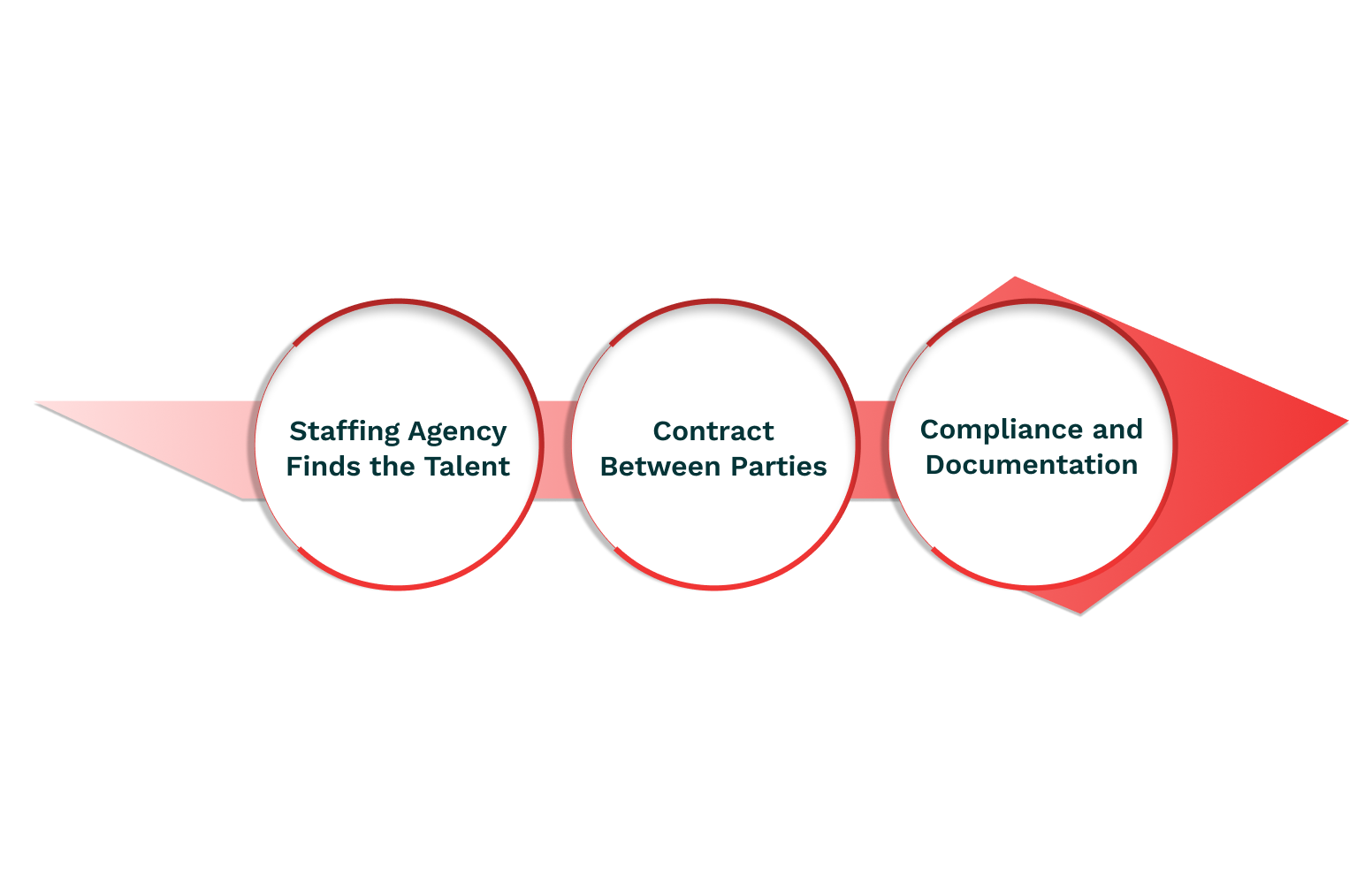
- Staffing Agency Finds the Talent: The staffing agency finds the right H1B candidate, and instead of directly hiring the candidate, they employ them through a third-party corporation.
- Contract Between Parties: The staffing agency contracts the talent to the client. This arrangement helps bypass many of the challenges and paperwork associated with traditional H1B employment.
- Compliance and Documentation: The staffing agency or third-party corporation ensures compliance with visa laws, handling all necessary paperwork, including payroll and benefits.
This process reduces administrative burdens for the client while ensuring the H1B worker is legally employed, making the entire hiring process faster and more efficient.
Now, let’s explore how C2C sponsorship can benefit both staffing agencies and businesses looking for H1B workers.
For a deeper dive into the differences between various employment models, check out our guide on Understanding W2 vs C2C: Key Differences Explained.
How Does Corp to Corp Sponsorship Work for H1B Jobs?

For staffing agencies, finding the right H1B talent quickly while ensuring legal compliance can feel like a juggling act. That’s where Corp to Corp (C2C) sponsorship shines.
Let's understand how it works:
Step 1: Staffing Agency Finds the Right Talent
The first step is identifying skilled H1B professionals who meet your client’s needs.
Once the talent is sourced, the staffing agency employs the candidate through its own corporation or a third-party corporation, not directly with the client.
Step 2: Contract Agreement Between Staffing Agency and Client
Next, the staffing agency enters into a contract with the client company.
This agreement outlines the terms of employment for the candidate, who remains on the staffing agency’s payroll, not directly with the client.
Step 3: Compliance and Legal Management
The staffing agency or third-party corporation ensures all visa-related compliance is met.
This includes handling visa documentation, payroll, and benefits, so the client doesn’t have to worry about legal complexities.
Step 4: Ongoing Monitoring and Support
Throughout the employment period, the staffing agency provides support to both the client and the candidate.
This includes checking in on performance, offering career support to the candidate, and maintaining compliance with work authorization requirements.
By following these steps, staffing agencies can place H1B talent with ease, reducing the burden on both the client and the candidate.
Ready to simplify your H1B hiring process? Reach out to Consultadd today and experience seamless C2C sponsorship solutions.
Now that you understand the basics of how C2C sponsorship works, let’s explore the benefits for both staffing agencies and employers in the next section.
Why Companies Choose Corp to Corp Visa Sponsorship for H1B Jobs
Hiring H1B talent can be tricky, with all the paperwork, compliance issues, and admin tasks. That’s where Corp to Corp (C2C) sponsorship comes in, making the process smoother for everyone involved. Here’s why many companies prefer C2C sponsorship when hiring H1B workers:
With all these benefits, it’s easy to see why C2C sponsorship is becoming the go-to option for hiring H1B talent.
Now, let’s dive into the legal and compliance details in the next section.
The Legal and Compliance Aspects of Corp to Corp Sponsorship
When it comes to hiring H1B talent through Corp to Corp (C2C) sponsorship, there are a few key legal and compliance questions you might have.
Don’t worry! We’re here to clear things up.
Let’s take a look at some common queries that come up, and make sure you’re ready for the legal side of the process.
Q1: What responsibility does the staffing agency have in C2C sponsorship?
A: The staffing agency is in charge of employing the H1B worker. This means they handle all the legal stuff, visa compliance, paperwork, payroll, benefits, taxes, you name it.
Q2: Does the client company need to worry about compliance too?
A: Not as much! While the client company still needs to make sure the worker is doing the job as agreed, they don’t need to handle any visa-related paperwork. That’s all on the staffing agency or third-party employer.
Q3: How is C2C sponsorship different from direct H1B sponsorship when it comes to compliance?
A: Great question! In direct H1B sponsorship, the client company has to handle all the visa paperwork and compliance. With C2C, the staffing agency takes care of it, so the client company can focus on the job at hand, not the legal details.
Q4: What happens if the staffing agency doesn’t stay compliant?
A: Yikes! Non-compliance can lead to big problems like fines or penalties. In some cases, it can even affect the H1B worker’s visa status. Keeping up with visa rules is crucial to avoid these risks.
Q5: How can staffing agencies make sure they stay compliant?
A: It’s all about staying informed. Agencies should work with immigration experts and make sure they’re following all the latest visa regulations. Plus, keeping detailed records helps keep everything above board.
Now that we’ve tackled the legal side, you’re in a better place to handle C2C sponsorship with ease.
Let’s move on and explore some of the challenges and considerations you should keep in mind when using this method for H1B jobs.
Challenges and Considerations in Corp to Corp Sponsorship for H1B Jobs
While Corp to Corp (C2C) sponsorship makes it easier to hire H1B talent, it’s not always a walk in the park.
There are a few things to keep in mind when going through the process, especially when managing the legal side and dealing with multiple parties.
Let’s go over some of the most common challenges and considerations that staffing agencies should be aware of.
These challenges might seem like a lot, but knowing them upfront helps you manage the process better.
Pro Tip: With C2C sponsorship, there are multiple parties involved. To keep things smooth, make sure everyone, clients, staffing agencies, and candidates, are on the same page with clear expectations and regular updates.
Conclusion: The Power of C2C Sponsorship for Simplified H1B Hiring
Using Corp to Corp (C2C) sponsorship for H1B jobs offers several key benefits for staffing agencies. It simplifies the hiring process, reduces administrative burdens, and ensures compliance with visa regulations.
How Consultadd Can Help with Corp to Corp Visa Sponsorship for H1B Jobs?
- Pre-screened candidates: Access a pool of thoroughly screened, qualified H1B candidates ready for placement.
- Visa compliance support: Consultadd ensures all documentation and legal requirements are met, reducing the risk of non-compliance.
- Streamlined process: We handle all the complexities of the C2C sponsorship process, from paperwork to onboarding.
- Ongoing support: Our team provides continuous support to both staffing agencies and H1B candidates, ensuring smooth transitions and compliance.
If you’re ready to simplify the process of hiring H1B talent and reduce your agency's administrative load, consider the C2C sponsorship option.
Partner with Consultadd for efficient, compliant, and reliable H1B staffing solutions.
Frequently Asked Questions (FAQs)
1. What is Corp to Corp (C2C) sponsorship for H1B jobs?
C2C sponsorship is an arrangement where staffing agencies employ H1B candidates through a third-party corporation, simplifying the hiring process and reducing compliance risks.
2. How does C2C sponsorship benefit staffing agencies?
It reduces administrative burdens, ensures compliance with visa laws, and provides quick access to pre-vetted, qualified candidates.
3. What role does the staffing agency play in C2C sponsorship?
The staffing agency employs the H1B candidate, handles compliance, and manages paperwork, while the client company focuses on the job itself.
4. Can C2C sponsorship help speed up the hiring process?
Yes, with pre-screened candidates and a streamlined process, C2C sponsorship can significantly reduce time-to-hire.
5. How can Consultadd help with C2C sponsorship for H1B jobs?
Consultadd provides access to a pool of pre-vetted candidates, ensures full visa compliance, and offers ongoing support throughout the hiring process.
Have more questions? Reach out to Consultadd!
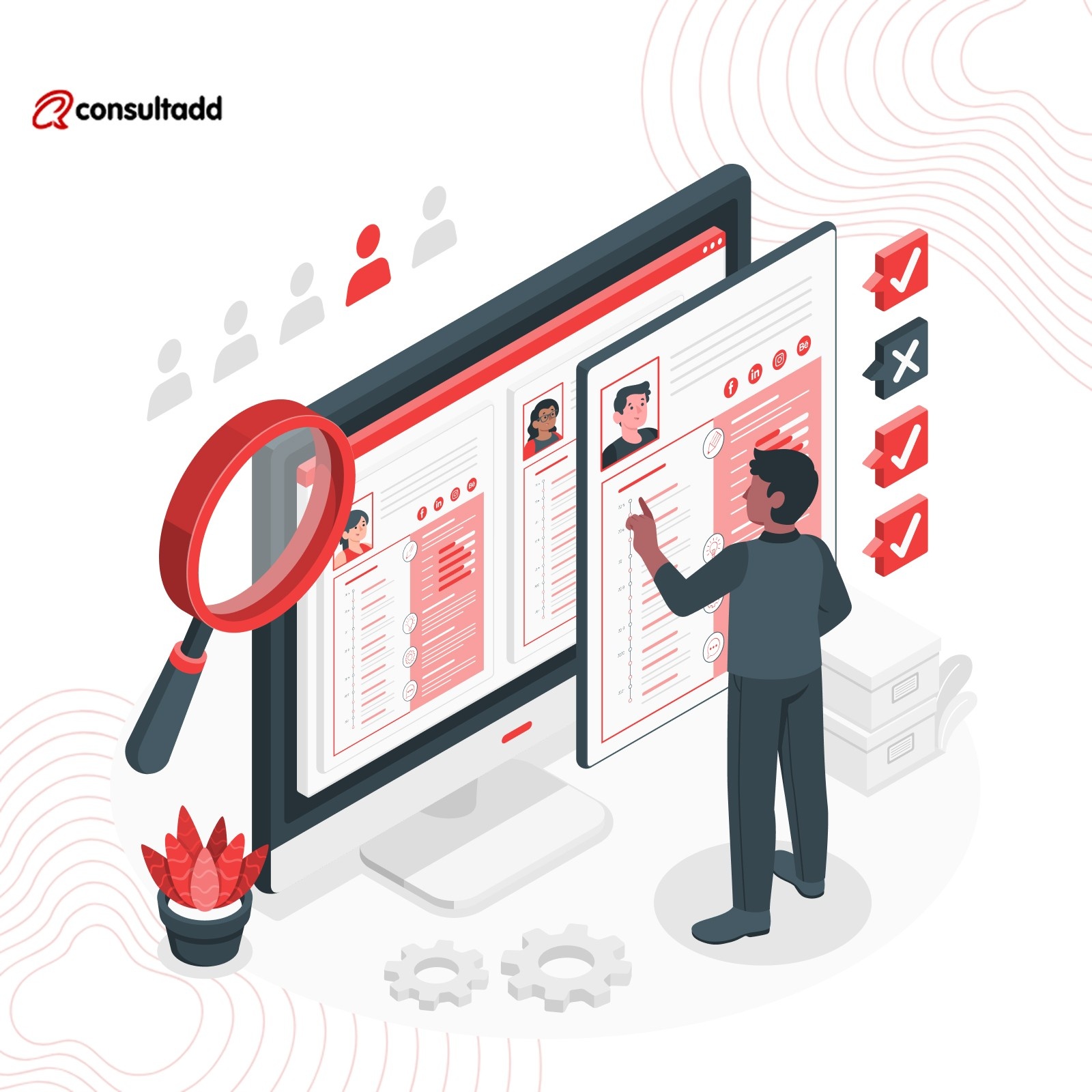
Understanding Skill Gap and Ways to Address It in 2025
You’re expected to deliver qualified candidates quickly but the right ones are getting harder to find.
You reach out, follow up, wait… only to realize the skills just aren’t there. Or worse, they’re close but not close enough.
It’s not just you. Around 74% of employers worldwide are already feeling the pressure of skills shortages. And in 2025, that pressure is only growing.
The skills gap isn’t about missing resumes, it’s about missing capabilities. Roles are evolving faster than talent can catch up, and staffing agencies are left holding the gap.
But here’s the upside: understanding where those gaps exist and how to close them is the first step to delivering real value to your clients.
In this blog, we’ll understand what the skills gap really means in 2025, why it’s become mission-critical, and how you can stay ahead of it.
TL;DR
- Skills gaps are widening fast: AI, automation, and evolving tech outpace traditional hiring and training models.
- Hiring for roles won’t cut it: You need to hire for capabilities, not resumes or degrees.
- Strategic actions win: Upskilling, internal mobility, and skill-first hiring are now competitive advantages.
- Consultadd delivers future-ready talent: With vetted candidates, 24-hour sourcing, and post-hire support, we help you close gaps before they cost you.
Understanding the Skills Gap in 2025
You’re moving fast, reviewing profiles, setting up interviews, managing client expectations.
But what happens when the talent you find can’t do the work your client needs?
What Is a Skills Gap?
A skills gap is the mismatch between an employee’s current capabilities and the skills required to succeed in a role now or in the future.
The Nature and Types of Skills Gaps in 2025
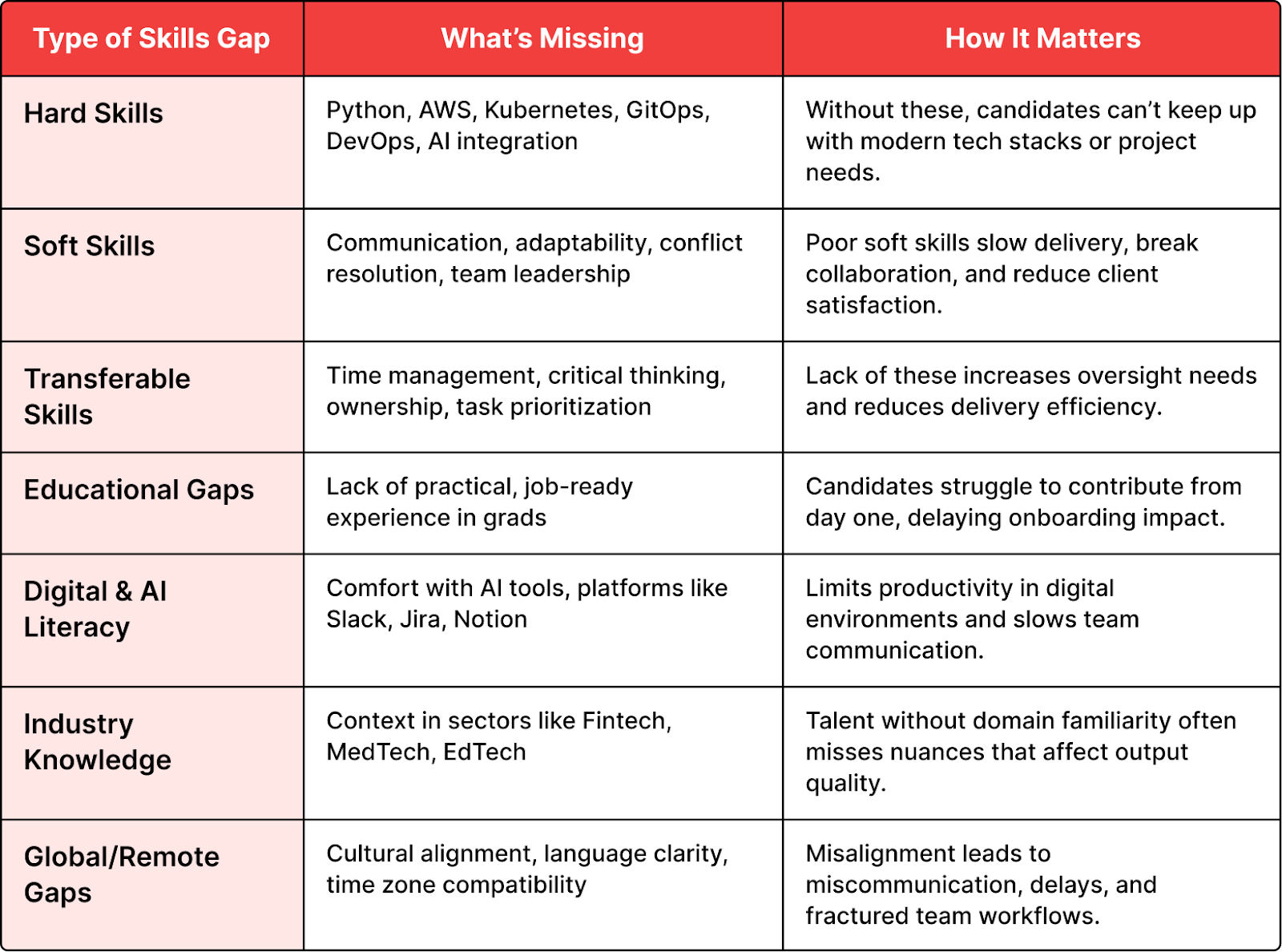
In 2025, skills gaps reflect missing real-world readiness, spanning various types.
Causes of the Skills Gap Today
1. Tech Disruption
AI, automation, and cloud technologies are advancing at breakneck speed.
Most teams can’t train fast enough to keep up with evolving tools and platforms.
2. Job Fragmentation
Roles are no longer siloed, one DevOps engineer may need to code, secure, and deploy.
This blend of responsibilities creates unrealistic expectations for a single hire.
3. Outdated Education
Many institutions still focus on theory and outdated tools.
Graduates often enter the workforce lacking job-ready, hands-on experience.
4. Static HR Practices
Relying on degrees, resumes, or job titles overlooks practical skill and growth potential.
Traditional hiring methods miss hidden talent and limit diversity in skill sets.
5. Limited Upskilling
Internal upskilling is often reactive, not planned.
Top performers are frequently sourced externally instead of being developed from within.
Why Closing the Skills Gap Is Mission-Critical
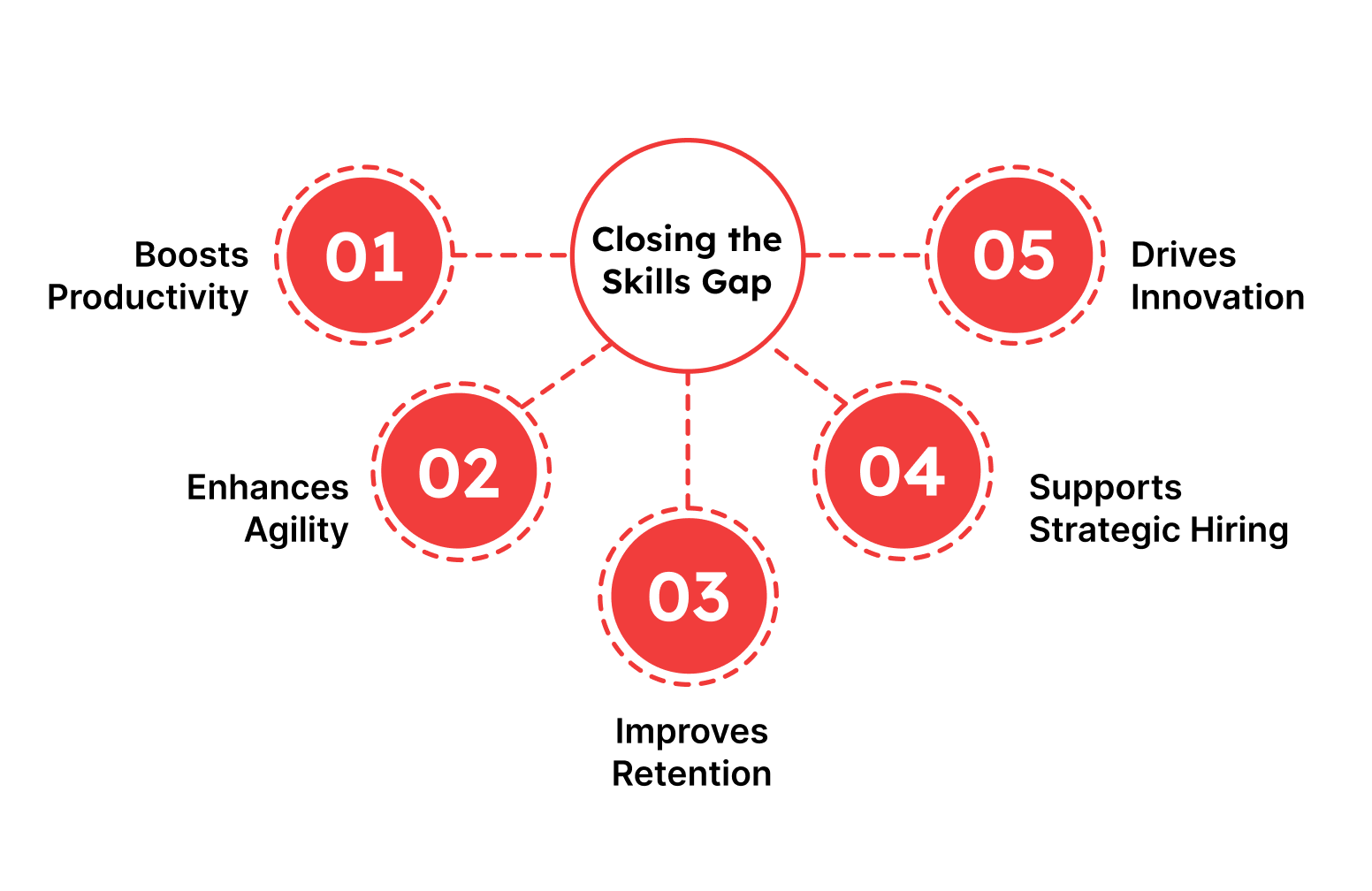
Closing the skills gap isn’t just a talent issue, it’s a business imperative.
- Boosts Productivity
Skilled talent doesn’t just complete tasks; they do it faster, smarter, and with fewer errors.
This means less hand-holding, quicker turnarounds, and more trust from clients. - Enhances Agility
Teams with up-to-date skills can shift gears with changing tech or project needs.
This flexibility helps you meet evolving client demands without missing a beat. - Improves Retention
Employees who are trained and growing are more likely to stay and deliver long-term value.
Upskilling shows investment, which builds loyalty and reduces costly turnover. - Supports Strategic Hiring
It’s not just about speed, it’s about accuracy.
Identifying and filling actual skill gaps helps you match the right candidate to the right role. - Drives Innovation
Fresh skills spark fresh thinking.
When teams are equipped with current knowledge, they bring ideas that keep clients ahead of the curve.
How to Identify Skills Gaps in 2025
You can’t fill what you can’t see.
And in 2025, invisible skill gaps cost time, trust, and revenue.
Therefore, spotting these gaps early helps you pitch stronger candidates, build client confidence, and reduce rework.
1. Conduct a Skills Gap Analysis
If hiring feels like a guessing game, you’re not alone.
Placing great candidates starts with knowing exactly what’s missing and where.
A skills gap analysis eliminates the guesswork.
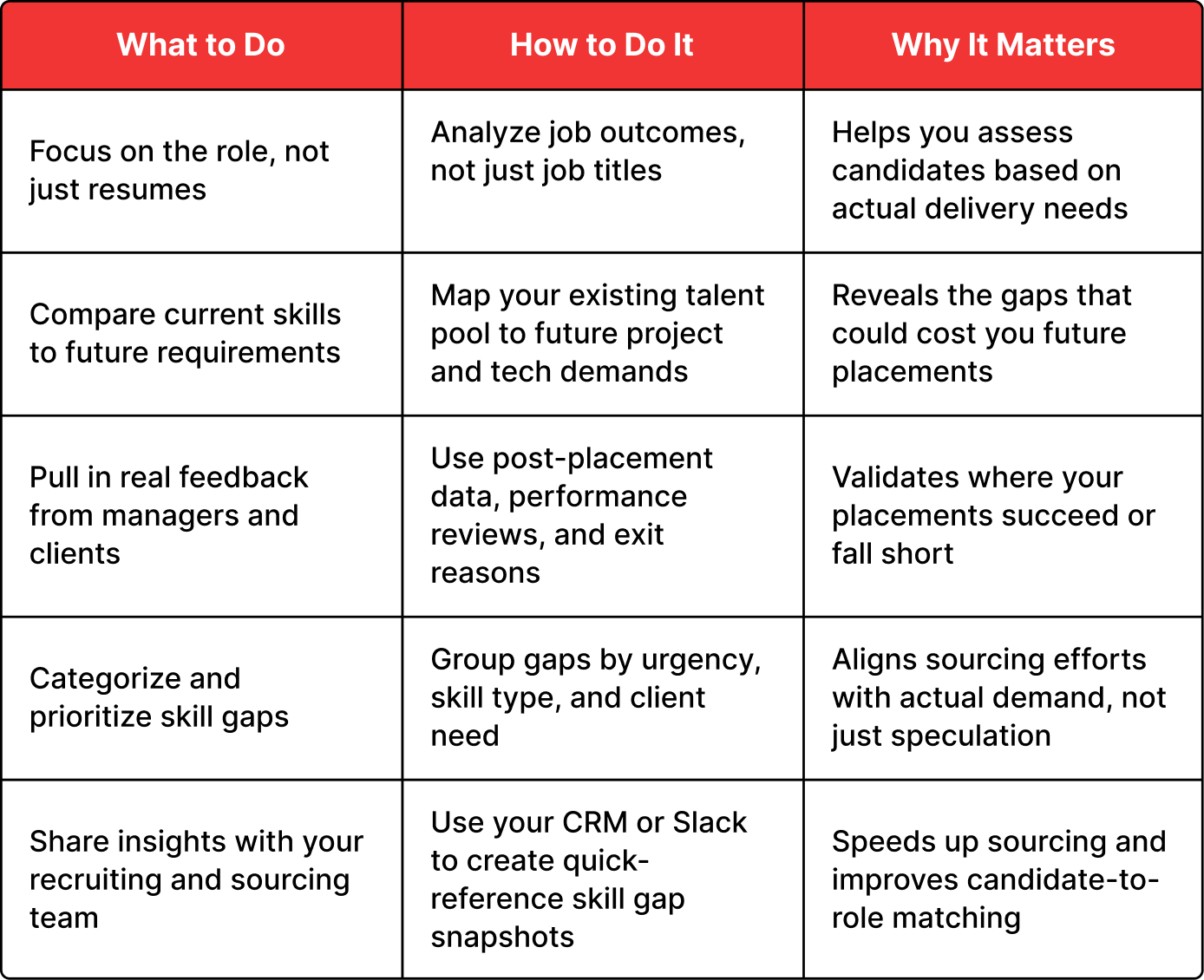
2. Use Feedback Mechanisms

Instinct isn’t enough when hiring is on the line.
Feedback gives you the clarity that resumes and interviews often miss.
- Post-Placement Feedback Loops
Ask hiring managers what worked and what didn’t after 30, 60, or 90 days.
Spot recurring skill issues in real-world delivery. - 360° Reviews with Candidates
Let candidates self-evaluate, then compare it with peer and manager input.
This reveals blind spots and overestimated strengths. - Quick Hiring Team Surveys
Use 3–5 focused questions after every hire.
Track consistent themes around preparedness, skill gaps, and fit. - Build a Feedback Bank
Capture input across roles, teams, and placements in one place.
Use it to adjust sourcing, prep, and placement decisions faster.
3. Maintain Skills Inventories
When speed matters, guesswork costs you.
An up-to-date skills inventory helps you pitch faster, fill smarter, and stay one step ahead.
Keep a live record of skills so you don’t start from scratch with each new requirement.
Here’s what your inventory should capture:
- Verified hard skills
- Soft skills and team traits
- Industry exposure
- Certifications and tooling
- Availability and work status
Update these regularly, post-interview, after client feedback, or once new training is complete.
Proven Ways to Address Skills Gaps in 2025
You’ve identified the gap, now what?
The right moves today can help you meet client demands before they even ask. It’s not just about patching holes. It’s about building a bench of talent that’s future-ready.

Jason Wingard, former President of Temple University, said:
“Successfully navigating complex change requires the ability to lead people through uncertainty.”
During his leadership, he pushed institutions to align learning with real-world needs, something staffing leaders must do too.
1. Develop Internal Talent with Personalized Learning
When the right talent is hard to find, build it.
Your bench could be stronger than you think.
What this looks like in action:
- AI-curated learning paths
Recommend training based on role, project, or client stack. - Access to top learning platforms
Think: LinkedIn Learning, Coursera, Udemy, not generic webinars. - Mentorship and job shadowing
Real-world exposure builds confidence and clarity. - Cross-functional projects
Let engineers try DevOps, or QA folks explore automation. - Micro-certifications
Quick wins in tools like AWS, Kubernetes, or GitHub Actions.
When learning feels relevant, talent sticks and grows.
2. Implement Dynamic Workforce and Succession Planning
Workforce plans can’t live in spreadsheets anymore because the client needs tend to shift overnight.
What’s missing today isn’t just people. It’s people with the right skills, at the right time.
The fix? Build a system that constantly asks: “What roles will matter 6 months from now?”
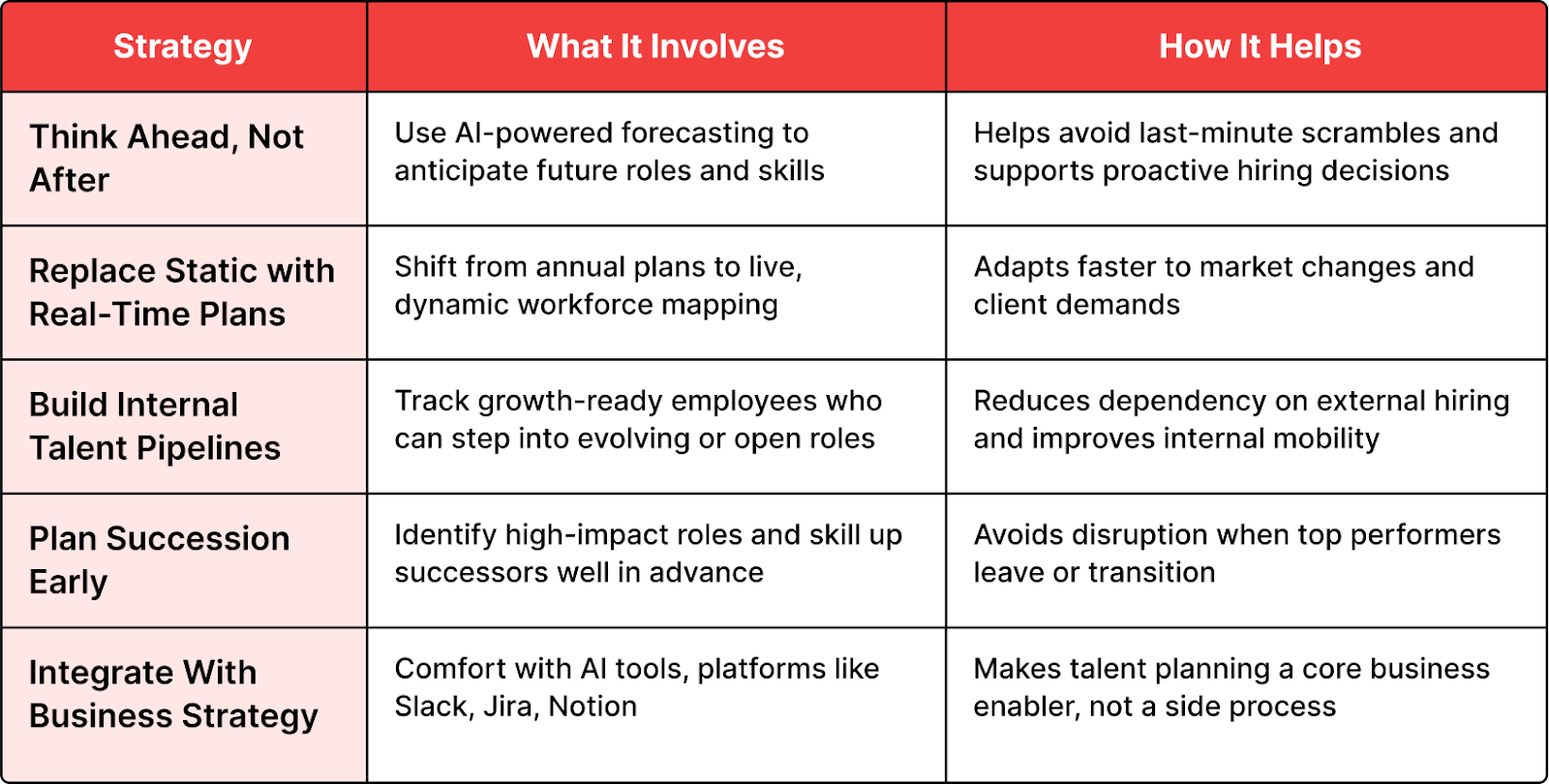
3. Embrace Skills-Based Hiring
a. Still filtering candidates by job titles and degrees?
That’s like judging a book by its publisher. Some of the best tech talent doesn’t come from traditional routes, they come with real skills, proven projects, and the grit to deliver.
b. What if you hired based on what candidates can do, not just what’s on paper?
Skills-based hiring puts capability front and center. Think task-first, test-first, and title-last.
c. Are your job descriptions filtering out great talent?
Revamp your listings to focus on deliverables, not credentials. A DevOps pro doesn’t need a four-year degree to build reliable pipelines.
d. How can you actually assess skills?
Skip generic interviews. Instead, try real-world challenges:
- Code tests
- Portfolio reviews
- Simulated tasks
- Paid pilot projects
e. Where can you find skill-rich, title-light candidates?
Look beyond the resume stack. Consider:
- Bootcamp grads
- Career switchers
- Freelancers and gig workers
- Community contributors (e.g., GitHub, open source)
When you hire for skill over status, you get candidates who perform, not just impress on paper.
Learn more about skills-based hiring in our blog: “Most Wanted Skills You Should Know in Skills‑Based Hiring”.
4. Strategic Partnerships & Industry Engagement
When the market moves fast, strong partnerships gives you early access to talent, insights, and demand before competitors catch on.
Why It Matters
- You can’t predict everything, but you can align with those shaping the future.
- Talent trends evolve quickly. Being inside the loop beats reacting from the outside.
What Strategic Partnerships Can Look Like
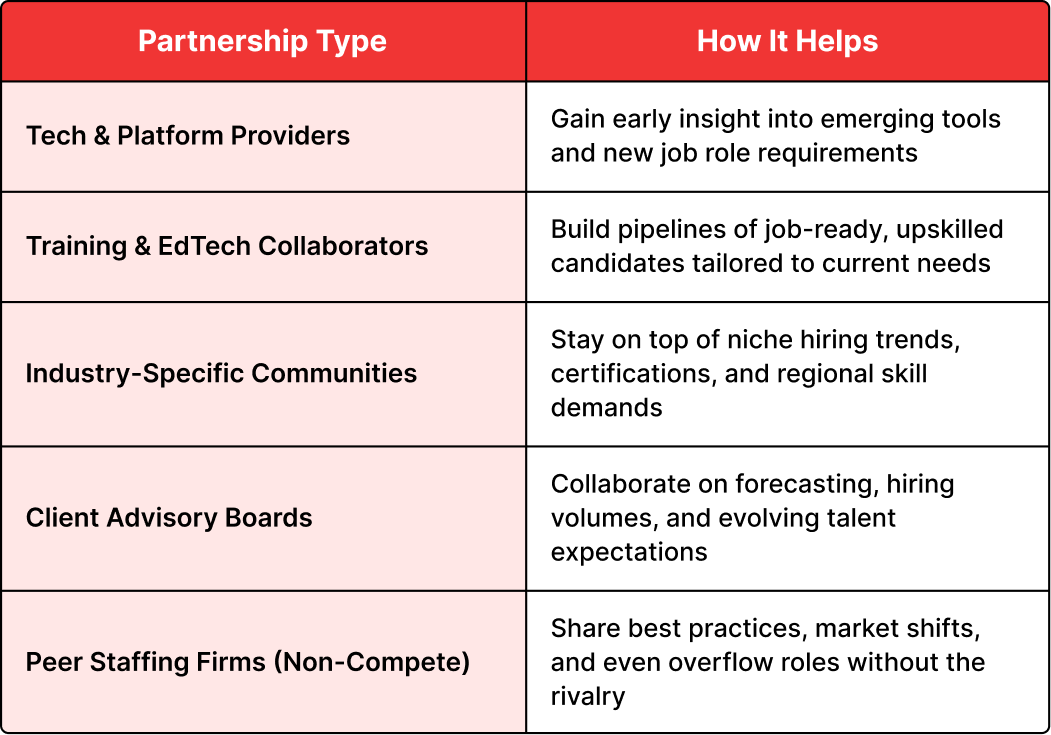
Pro Tip: Don’t wait for clients to tell you what they need, co-create the roadmap with them.
Remember, when partnerships are strategic, not transactional, you don’t just place talent, you shape the future of hiring.
5. Promote Internal Mobility and Cross-Functional Movement
Hiring externally isn’t always the fastest or the smartest answer. Sometimes, the perfect candidate is already inside the building. They just need the right push, plan, and platform.
- Build a Transparent Talent Marketplace
Let employees explore internal roles and express interest without stigma. - Create Cross-Training Opportunities
Rotate high performers into new teams for short-term projects or problem-solving sprints. - Recognize Transferable Skills
Don’t wait for an exact match, identify adjacent skills that fit the new role. - Support with Mentors and Microlearning
Guide transitions with short, focused training and peer support. - Reward Career Mobility
Celebrate lateral and vertical moves alike. Growth isn’t always about climbing.
6. Monitor Market Trends and Anticipate Emerging Skills
You can’t hire for tomorrow with yesterday’s job descriptions. Staying ahead means spotting skill shifts before others do.
Instead of reacting to change, lead it.
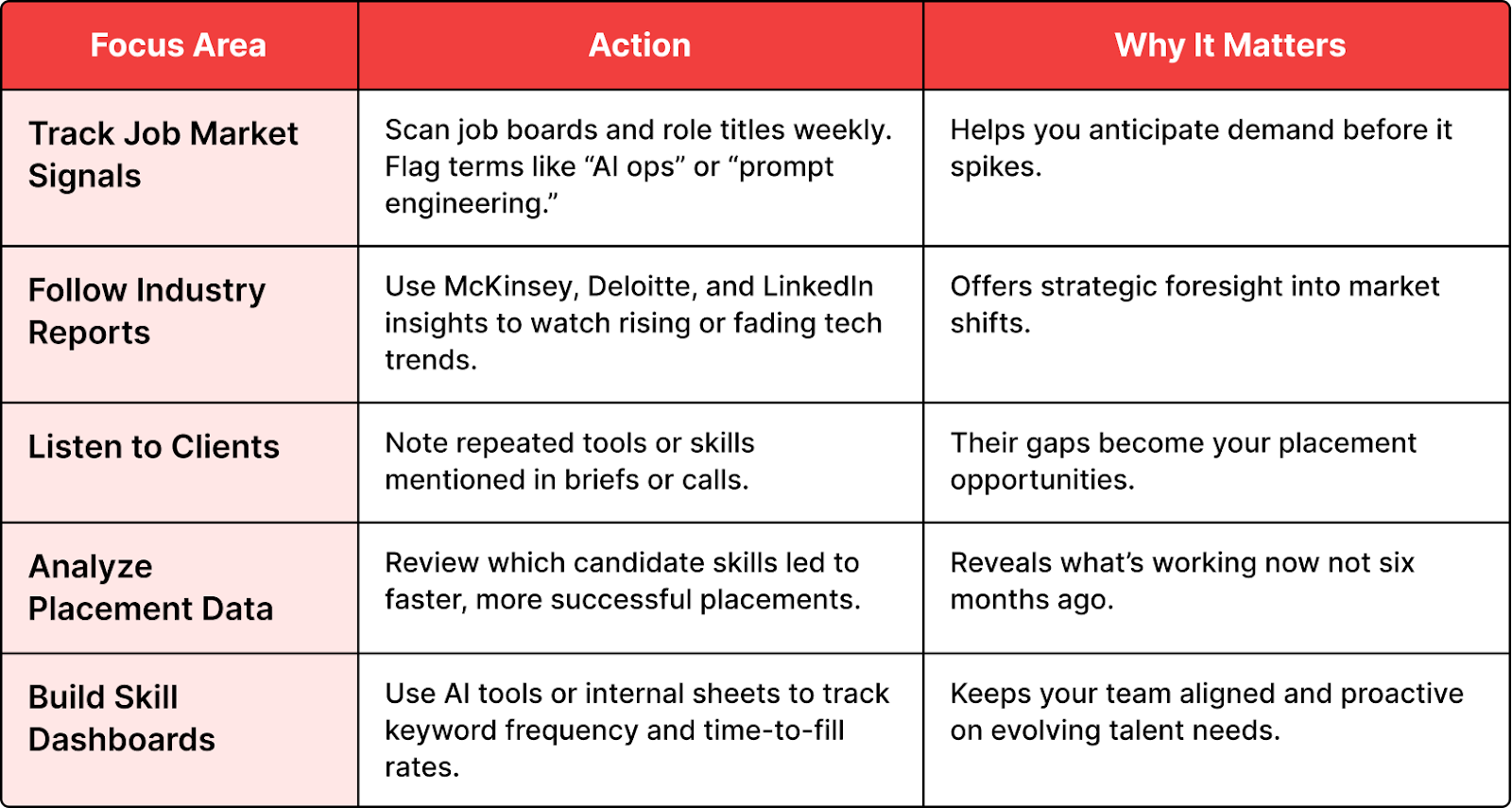
These proven ways become even more effective with Consultadd, as we deliver pre-vetted, ready-to-hire candidates with the exact skills clients need, fast and at scale.
Technological Enablers Closing Skills Gaps
Smart tech is reshaping how staffing firms detect and close talent gaps quickly, precisely, and at scale.
Here’s how top recruiters are gaining an edge:
1. AI-Powered Skill Mapping
Quickly links resumes to in-demand skills using real-time data.
Helps uncover qualified candidates others overlook.
2. Predictive Analytics
Forecasts upcoming skill demands based on hiring trends.
Let's you prep before the market feels the pressure.
3. Adaptive Learning Platforms
Offers up-to-date courses aligned with emerging tech roles.
Enables candidates to stay job-ready and relevant.
4. Talent Intelligence Systems
Combines market insights and performance data to guide hiring.
Improves placement speed and strategic fit.
Smart tech is reshaping how staffing firms detect and close talent gaps quickly, precisely, and at scale. For a strategic overview, check out our blog: “Creating a Strategic Talent Management Framework for 2025”.
Addressing Skills Gap Challenges with Future-Proof Solutions
Skills gaps are no longer a future problem, they’re today’s bottleneck. Solving them demands smarter systems, not just faster hiring.
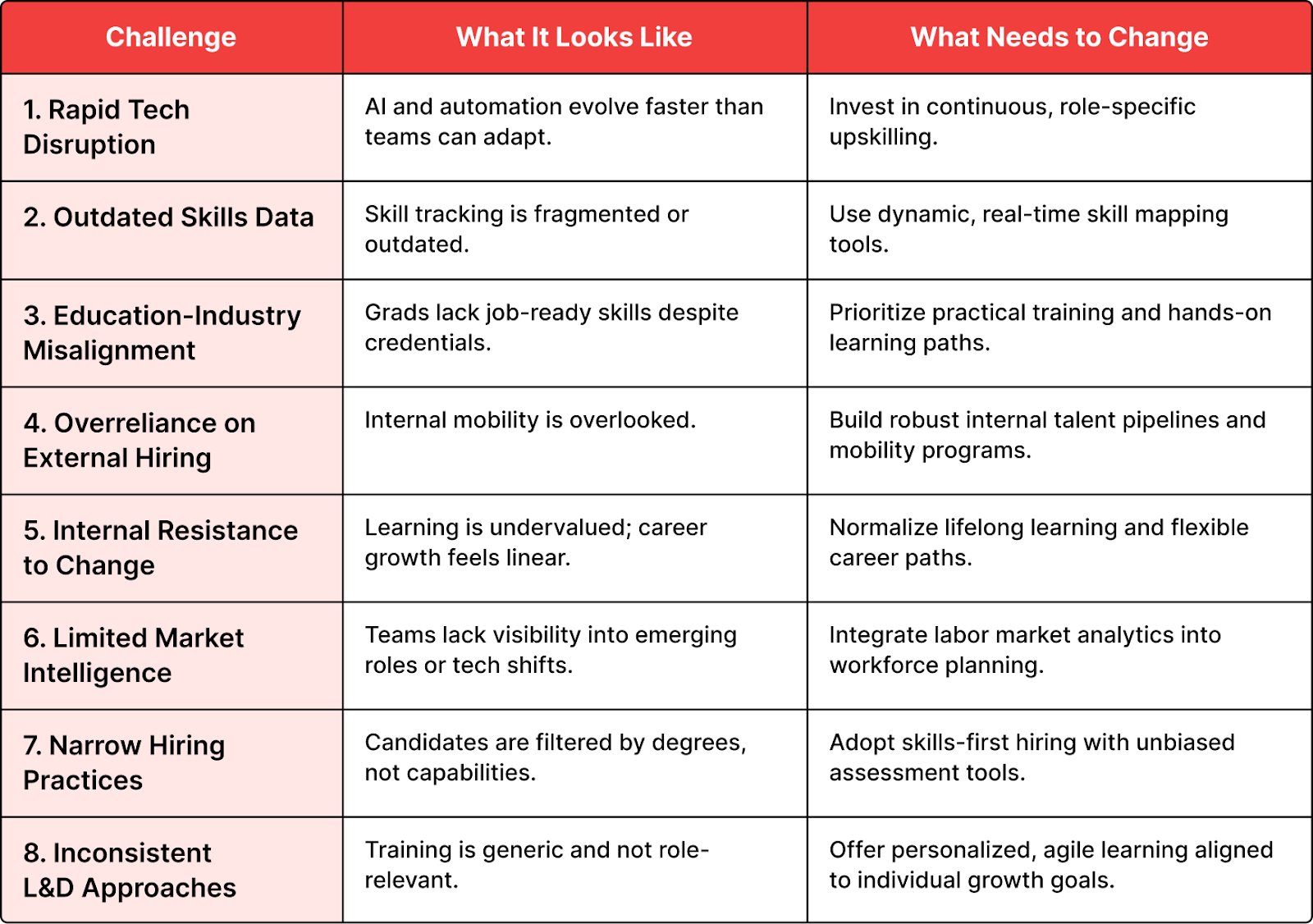
Consultadd uses deep domain expertise to match talent quickly and accurately. From compliance to engagement, every candidate is screened to reduce risk and hiring delays.
Conclusion: Bridging Skills Gaps Is the Blueprint for Long-Term Success
Skills gaps aren’t just a talent problem, they’re a growth blocker. Staffing agencies that act now, with speed and strategy, will become the true drivers of innovation.
That’s where Consultadd becomes your true partner in transformation.
With 14+ years of experience and 5,000+ successful staffing engagements, we’ve seen the market shift and we’ve helped our clients stay ahead of it.
Our 1:1 account managers don’t just fill roles; they help you build pipelines.
From top 100 candidates placed last year to MSAs with leaders like Robert Half and Teksystems, we know how to deliver high-impact results at scale.
Expect more than placements:
- Safe, reliable hires, thoroughly vetted for compliance and skill
- Ready-to-deploy talent, sourced in less than 24 hours
- Lower attrition, thanks to deep commitment and cultural alignment
- Seamless compliance, including visa support and documentation
- Ongoing support, so hires continue to thrive post-placement
- Backed by strong university ties and trusted by 65+ staffing partners annually
The skills gap isn’t going away. But with Consultadd, neither is your competitive edge.
Get in touch and let’s build the future of staffing together.
FAQs
1. What are the skills gaps in 2025?
Skills gaps in 2025 include deficits in AI, cloud computing, cybersecurity, digital literacy, and soft skills like adaptability. Roles are evolving faster than talent can keep up, leaving critical capabilities unfilled.
2. How to address the skills gap?
Address skills gaps by investing in upskilling, using skills-based hiring, enabling internal mobility, and leveraging tech-driven talent mapping. Proactive planning and continuous learning help build future-ready teams.
3. What is skills gap understanding?
It means identifying the mismatch between current employee capabilities and the skills required for present or future roles. This understanding enables targeted development and better hiring decisions.
4. What are the biggest skill gaps?
The largest gaps are in AI/ML, cybersecurity, cloud-native tools, digital communication, and leadership. Employers also struggle to find candidates with critical thinking, collaboration, and real-world problem-solving abilities.
5. What is the skills gap model?
The skills gap model compares existing workforce skills to those needed for optimal performance. It helps organizations pinpoint shortages, prioritize learning efforts, and align talent strategy with business goals.
6. What is the skills gap in technology?
Technology skill gaps refer to a lack of expertise in areas like AI, DevOps, cloud platforms, and cybersecurity. As digital tools evolve, many workers lack the training to keep pace.

W2 vs C2C: Key Insights for Visa Holders
Finding the right tech talent quickly is tough, especially when you’re working with visa holders. Candidates often hesitate or drop out when contract terms come up, making your job harder.
This is where understanding W2 and C2C hiring models becomes crucial. Each approach has unique implications for visa holders, affecting compliance, cost, and project flexibility.
While both W2 and C2C models serve essential roles, C2C has emerged as the preferred model for many fast-moving businesses due to its cost efficiency, agility, and access to a broader talent pool.
For hiring managers, choosing the right model isn’t just about filling roles fast, it’s about managing risk and meeting client expectations without surprises.
Let’s understand W2 and C2C visa procedures, focusing on key insights for visa holders and what it really means in today’s market.
An Overview of W2 and C2C Models
In the competitive world of staffing, every decision counts especially when it comes to choosing the right hiring model.
The choice between W2 and C2C can make or break your ability to place top tech talent efficiently, especially for visa holders navigating complex compliance.
Understanding W2 Model
- Defines a formal employer-employee relationship with the staffing firm as the employer.
- Payroll taxes, benefits, and legal compliance are handled centrally by the client.
- Supports strict adherence to Department of Labor and USCIS regulations.
Understanding C2C Arrangements
- A business-to-business agreement where the candidate provides services through their a corporation (often an LLC).
- The staffing firm contracts directly with the candidate’s company, shifting payroll and tax responsibilities.
- Requires thorough documentation to ensure the contractor’s corporate entity complies with visa rules.
Why This Matters for Visa Holders
Visa holders operate under strict legal frameworks requiring precise compliance.
When placing H-1B, L-1, or other visa holders, choosing between W2 and C2C is more than a preference, it’s a compliance necessity.
- W2 ensures oversight and reduces immigration risks with direct employment.
- C2C offers cost efficiency and flexibility but requires rigorous verification.
Grasping these distinctions is key to transforming your hiring strategy.
To make smart hiring choices, it’s important to break down the core differences between these two models. Read our blog “Understanding W2 vs C2C: Key Differences Explained” to get a clear comparison of which model best fits your staffing goals especially when working with visa holders.
Legal and Compliance Insights: W2 vs. C2C Under H1B
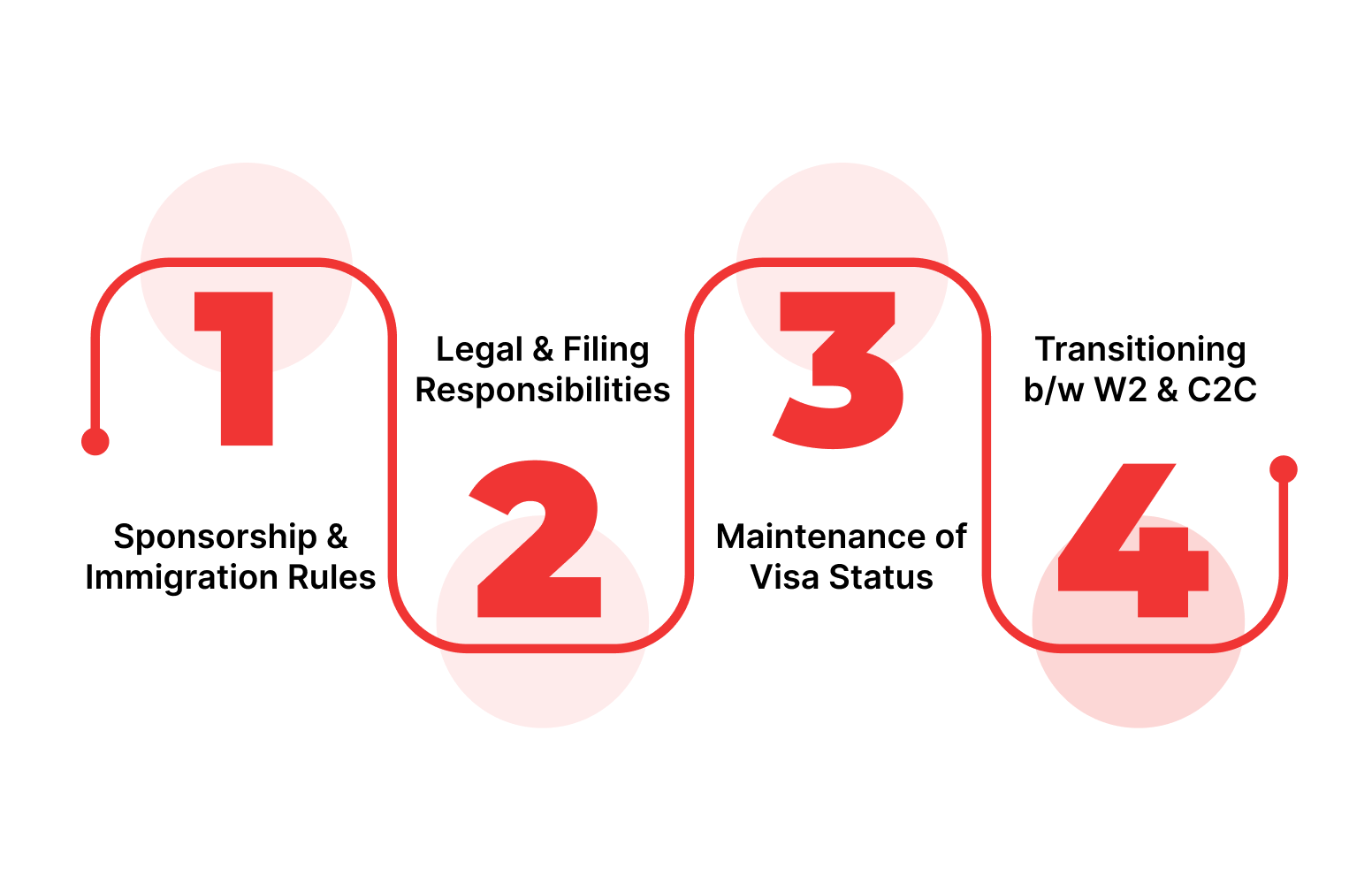
W2 or C2C? When it comes to H1B placements, knowing the compliance differences isn’t optional, it’s critical. Stay sharp, stay compliant.
1. Sponsorship and Immigration Regulations
Understanding sponsorship and immigration rules is crucial for staffing agencies working with visa holders.
Key H1B Visa Rules
- H1B visa holders must be sponsored by a U.S. employer with a valid relationship.
- The sponsoring employer files Form I-129 with USCIS to initiate the process.
- A certified Labor Condition Application (LCA) from the Department of Labor is mandatory.
W2 Classification
- One sponsoring entity handles all immigration filings and LCA compliance.
- Clear oversight ensures compliance with wage, location, and role specifics.
C2C Classification
- Sponsorship may involve a third-party organization, adding complexity.
- Risk increases if employer-employee relationships aren’t well documented.
You must verify a valid corporate structure for visa compliance. Mastering these sponsorship details equips staffing agencies to confidently deliver compliant talent.
2. Legal and Filing Responsibilities
Mastering legal and filing responsibilities is key to empowering staffing agencies with speed, trust, and compliance.
That’s where Consultadd makes a difference. We reduce the stress of navigating visa and compliance requirements by providing pre-screened, ready-to-hire candidates with verified documentation and work authorization.
From reducing sourcing time to handling employment paperwork and benefits, we help you focus on delivering talent, not chasing paperwork.
3. Maintenance of Visa Status
Keeping visa status intact is non-negotiable and a challenge you must master.
Time-Sensitive Compliance
- H1B status ties directly to specific petition terms.
- Changes in work location, job title, or client require timely amendments.
- Missed updates risk out-of-status consequences, disrupting placements and client trust.
Accurate Recordkeeping
- Detailed documentation of contracts, work assignments, and locations is essential.
- This protects both the visa holder and your agency from compliance pitfalls.
- Regular audits of paperwork keep processes airtight and reassure clients.
Alignment with Approved Terms
- Work must match the role, location, and duration approved in the visa petition.
- Deviations invite legal complications and jeopardize future hiring opportunities.
With vigilant status maintenance, your agency stands as a confident leader in visa-compliant talent delivery.
4. Transition Between W2 and C2C and Vice Versa
Transitioning between W2 and C2C can unlock greater flexibility, especially when scaling talent quickly. While C2C offers streamlined onboarding, it’s a crucial step that directly impacts visa compliance and talent retention.
Avoiding Legal Gaps
- Even brief gaps in legal employment can cause visa status problems.
- Out-of-status candidates risk delays, penalties, or visa denials.
- You must ensure continuous, compliant employment during transitions.
Petition Amendments are Essential
- Any switch requires filing a new or amended H1B petition.
- USCIS approval is critical to validate changes in employment structure.
- Missing or delayed filings can jeopardize both candidates and agency reputation.
Essential Guidelines for Structuring Work Under an H1B Visa
Understanding how to properly structure work under an H1B visa is key to protecting your candidates and your business.
Clear rules help you stay compliant while providing clients with the right talent at the right time.
Benefits of W2 Model for Visa Holders
The W2 model gives staffing firms control and reliability in managing visa talent.
- Employer Control and Job Security
Direct employment ensures better oversight and reduces candidate turnover risks. - Simplified Tax Withholding and Compliance
Staffing firms handle payroll taxes, lowering legal risks and administrative burdens. - Value-Add through Benefits
Offering benefits attracts top talent and improves client satisfaction with placements.
Considerations of W2 Model for Visa Holders
While W2 offers stability, staffing firms face challenges balancing cost and compliance.
Higher Operational Costs
Employer taxes and benefits increase overall expenses per placement.
Less Flexibility for Short-Term Projects
W2 is less suited for quick, project-based hiring needs.
Increased Administrative Load
Managing immigration compliance and paperwork demands extra resources and vigilance.
Whether you’re facing long hiring cycles, struggling with unqualified applicants, or dealing with complex visa compliance, Consultadd has you covered.
While W2 offers structure, C2C provides speed, cost efficiency, and talent flexibility, the traits modern businesses value most. That’s why more and more agencies are moving toward C2C as the preferred model for scaling tech talent.
As the direct C2C contractor, we handle everything from immigration documentation and payroll to 401(k), relocation, and insurance so staffing agencies can confidently scale talent and deliver on client demands quickly and compliantly.
Benefits of C2C Model for Visa Holders
The C2C model offers staffing agencies fresh advantages, especially for visa holders. It’s a game-changer that brings agility, cost savings, and access to specialized talent — all critical in today’s fast-paced market.
Before we dive into the risks, it’s worth understanding why C2C is quickly becoming the go-to staffing model for modern, fast-moving businesses. Read our blog “Why C2C Contract Hiring Solutions Are Ideal for Modern Businesses?” to explore how this model delivers flexibility, cost savings, and access to high-demand talent all without compromising on speed or quality.
Considerations of C2C Model for Visa Holders
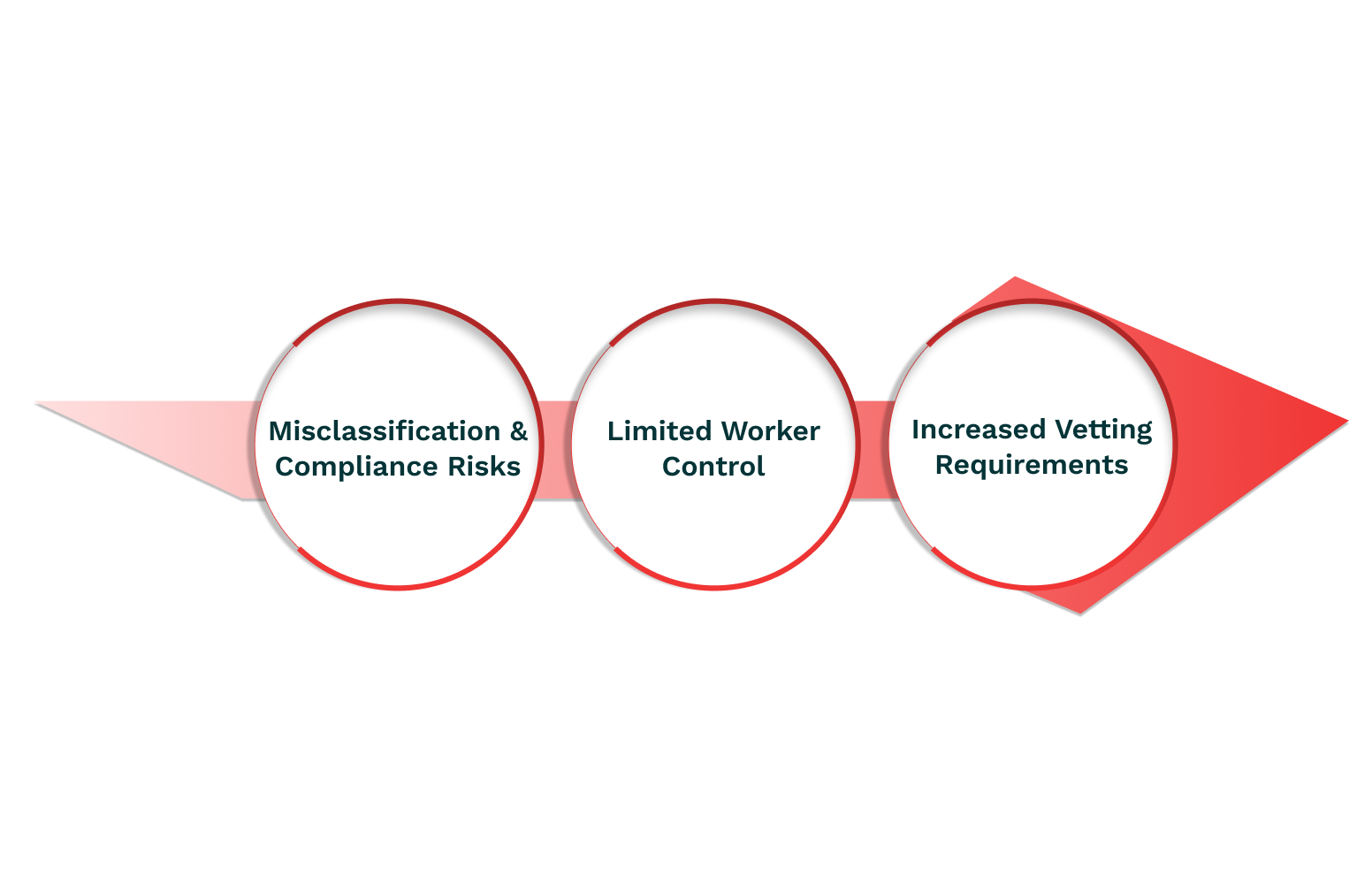
The C2C model offers freedom but comes with risks agencies must handle smartly.
1. Risk of Misclassification and Compliance Gaps
Improper contracts and missing documents can trigger audits and penalties.
2. Limited Control Over Worker Performance
Less oversight may cause inconsistent results and missed deadlines.
3. Increased Vetting Requirements
Thorough checks on business legitimacy and visa status are essential.
Knowing these helps agencies manage risks effectively.
Moreover, Consultadd handles all corporate due diligence up front. We verify visa status, and ensure control and supervision compliance, giving you peace of mind from day one.
Conclusion: Making Smart, Compliant Decisions in H1B Staffing
In H1B staffing, cutting corners isn’t just risky, it’s costly. One misstep in documentation or visa status can derail client trust and delay delivery. That’s why top staffing agencies are choosing partners who bring more than just resumes, they bring reliability, speed, and long-term thinking.
Consultadd has been doing just that for over 14 years, serving as a trusted engine behind thousands of placements. We’re not just here to fill seats, we’re here to help you build a workforce that lasts.
Here’s how we ensure every hire is a smart, compliant decision:
- 5K+ successful staffing engagements completed across high-demand verticals
- ~65 staffing firms served in the past year, with repeat partnerships and glowing feedback
- Top 100 pre-vetted candidates shared annually to keep your pipeline full and competitive
- Ready-to-deploy talent with proven experience and verified immigration status
- Talent sourced in under 24 hours, cutting down time-to-fill and client friction
- 1:1 account managers who act as a strategic extension of your recruitment team
- Strong university relationships to access fresh, eager, and compliant talent
- MSAs signed with major partners, including Robert Half and Teksystems
Each candidate is meticulously vetted for compliance and performance, so you're not just filling roles you're hiring peace of mind. No last-minute dropouts. No document confusion. No finger-pointing when regulations change.
And the support doesn’t stop at placement. Consultadd stays connected post-hire, helping consultants grow and thrive because your success depends on theirs.
If you're ready to scale without the stress, we’re here to power your next move swiftly and compliantly. Let’s talk. Book a quick call with our team and experience the difference.
.png)
Understanding Different Types of Employment Status
You’ve sourced, screened, and prepped the candidate. Now you’re negotiating terms, but employment status is still a sticking point.
Maybe it’s because the role is contract-based. Perhaps it's confusion over pay, benefits, or what they’re signing up for. Either way, you're still confused.
For recruiters and hiring managers, employment status isn’t just a checkbox; it’s a deal-maker or a deal-breaker. It determines everything from legal protections and tax responsibilities to whether a candidate accepts the offer.
In April 2025, the U.S. reported 163.94 million people in employment. However, not all jobs or jobholders are created equal. Each full-time, part-time, or contractual employment status comes with its own set of expectations and obligations.
If you misunderstand it, you risk delays, compliance issues, or losing the candidate entirely. If you get it right, you set the stage for smoother placements, faster onboarding, and stronger relationships.
Let’s examine the different types of employment status and why they matter more than ever.
Types of Employment Status
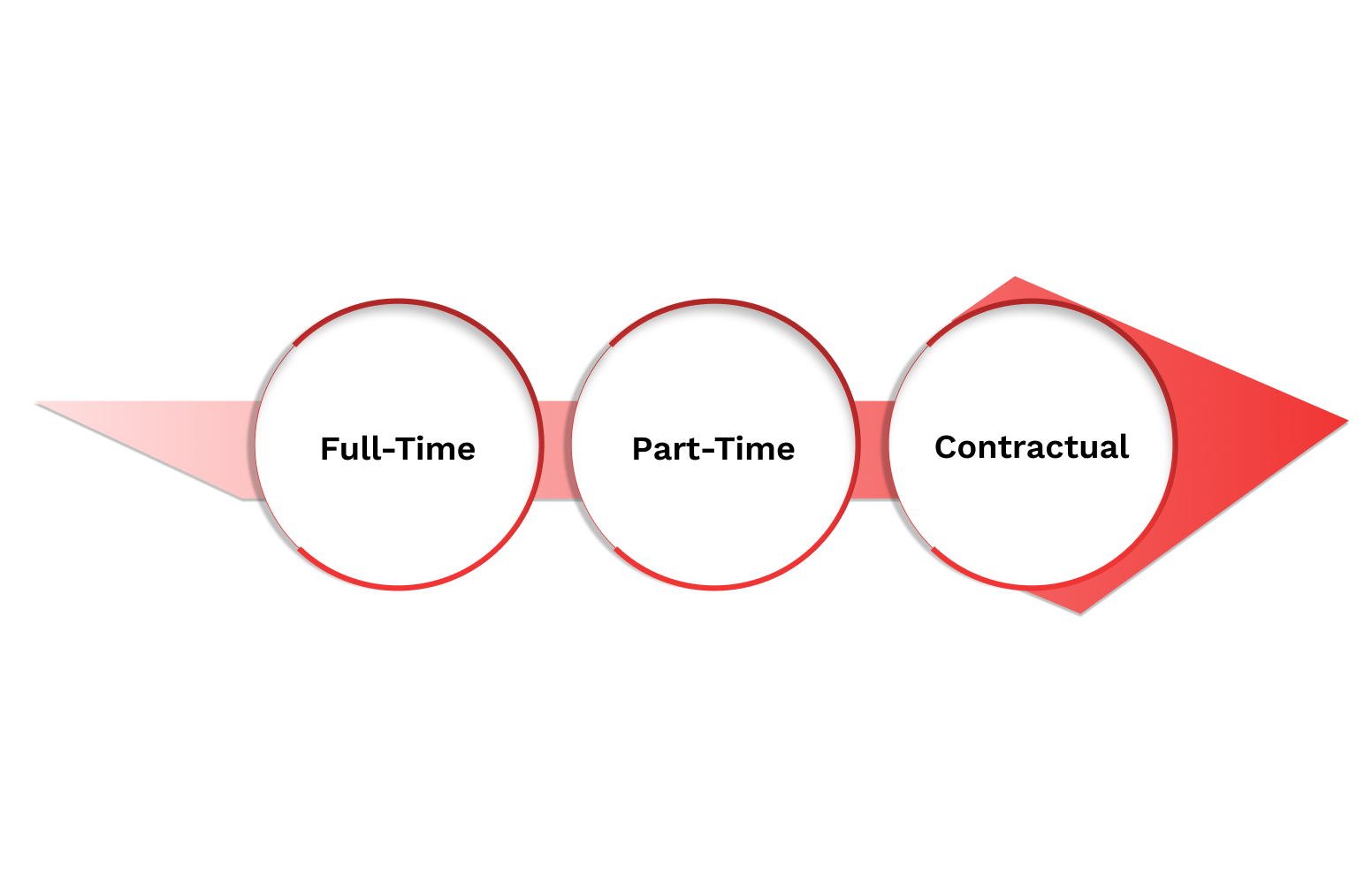
There are three primary types of employment status commonly used in the United States. These are as follows:
1. Full-Time
These individuals work 30–40+ hours per week under a formal contract with a single business.
- Fixed schedules: Set working hours and clear job responsibilities.
- Benefits eligible: Health insurance, paid time off, retirement plans, and more.
- Protected rights: Includes unemployment insurance, workers’ comp, and FMLA (Family and Medical Leave Act).
2. Part-Time
Part-time employees individuals have fewer scheduled hours (typically under 30 hours/week).
- Flexible hours: Often arranged around peak times or seasonal needs.
- Limited benefits: May include some workplace protections but often without full health or retirement benefits.
3. Contractual
Contractual employees are hired for a specific duration or project. This category includes:
- 1099 Independent Contractors: Self-employed individuals managing their own taxes.
- Corp-to-Corp (C2C): Individuals work via registered business entity (LLC or S-Corp).
Each status has its place, but matching it with the role and the expectations correctly is everything.
This is where Consultadd steps in. From screening candidates by classification to ensuring proper documentation and benefits alignment, we help you move from decision to placement faster with fewer risks and greater confidence.
Let’s see how these classifications shift globally, and why your location matters more than you think.
Global Perspectives on Employment Status
Talent knows no borders, but laws and classifications absolutely do.
When you work across borders, you manage time zones and interviews as well as navigate different employment definitions, rights, and risks.
Miss the fine print, and you could be exposed to audits, fines, or lawsuits.
Here’s how employment status shifts worldwide, and what you must check before going global.
Varied Definitions, One Common Goal
Each country has its criteria for what makes someone a full-time, a part-time, or a contractual employee.
- U.S.: Classification hinges on control, how, when, and where work is done.
- U.K.: Recognizes three statuses, employee, worker, and self-employed, with layered rights.
- India: Adds complexity with contract labor laws and social security considerations.
- Canada: Heavily scrutinizes employer control and financial independence to avoid misclassification.
Pro Tip: A one-size-fits-all approach doesn’t work. Definitions shift your hiring strategy as well.
How Rights, Benefits & Protection Vary by Country?
Candidates around the globe don’t receive the same baseline protections.
Here’s what recruiters must check before presenting a candidate:
Pro Tip: Always check local classification tests before assigning status; it’s not just a formality, it’s a legal safeguard.
Must-Check Before Hiring Across Borders:
- Is the candidate entitled to benefits in their home country?
- Will the classification affect the client’s tax reporting obligations?
- Can the candidate legally provide services under a contract in that country?
If you're unaware of these differences, your placements could trigger legal or financial trouble.
Consultadd handles all U.S.-based compliance requirements, including tax regulations, employment classifications, and visa matters, so you can hire with confidence.
We help you avoid costly compliance missteps that could delay onboarding or damage client trust. Our support ensures that your placements are quick, seamless, and enduring.
Key Considerations for Changing Employment Status
Shifting a candidate from one employment status to another, such as from contractual to full-time or vice versa, isn’t a simple decision. It impacts compliance, cost, engagement, and client outcomes.
Here are the must-consider factors before making the change:
Changing status isn’t just about paperwork; it changes how people feel about work.
A study by Korea National University of Transportation revealed clear patterns in a financial institution’s temp-to-perm shift. Employees in planning or skilled roles were far more likely to secure full-time positions than those in routine or manual jobs.
Skilled or planning roles had better chances of conversion than those in simple tasks.
This distinction is critical when evaluating which roles are worth investing in for permanent transition and which may require reskilling.
The same study found that those transitioned to permanent roles reported higher job satisfaction and more substantial commitment to the company. If the business struggles with retention, this is a lever worth pulling.
Those converted to regular status reported higher job satisfaction and more substantial organizational commitment.
For hiring managers, this is a chance to future-proof relationships.
One of the most effective ways to bridge uncertainty, for both employer and candidate, is through the contract-to-hire model. In our blog, Should You Choose Contract-to-Hire? A Practical Look at the Model, we explain how this approach boosts flexibility, reduces turnover, and supports more intelligent scaling in competitive markets.
Remember: Even one change in employment status can trigger a domino effect. Make it count, clean, and always lead transparently for your team and the candidate.
Selecting the Right Employment Status
The candidate you hire shapes far more than their contract; they define outcomes. It impacts cost, culture, compliance, and the candidate’s long-term potential.
The right choice can drive retention, client satisfaction, and speed-to-fill. The wrong one can drain budgets and damage relationships.
Let’s explore how to get it right every single time.
Match the Status to the Role's Nature
Before you draft a contract, assess what the job actually requires.
Stay on the Right Side of Compliance
Misclassifying employees isn’t just risky, it’s expensive.
A contractor treated like an employee can trigger:
- Back taxes
- Legal action
- Reputational fallout
Align With Candidate Expectations
The talent you place isn’t just looking for a paycheck; they’re looking for purpose.
- Some crave the freedom of flexible work.
- Others seek the security of benefits.
- Many want to grow into long-term roles.
The right employment status ensures better engagement and stronger referrals.
Evaluate Long-Term Strategic Fit
Don't just solve the current problem, solve the one six months from now.
Ask:
- Will the business still need this role in a year?
- Can this person grow with the company?
- Is the client open to temp-to-perm transitions?
The best status supports both today’s sprint and tomorrow’s marathon.
Talent mapping offers a more innovative solution if you are still unsure about the long-term need for a role or face skill shortages. Read our blog, From Skills Gap to Strategic Growth: Talent Mapping That Delivers, we explain how talent mapping helps shift from reactive hiring to strategic workforce planning.
Remember that every hiring decision is a reflection of your judgment.
Conclusion: Confidently Choose Employment Status
Hiring managers are constantly under pressure to get employment decisions right.
One wrong call on status can affect compliance, trust, and talent satisfaction in seconds.
We at Consultadd have unpacked the key considerations, the global view, and how to choose the right employment status.
The goal? This is to help you always make smarter, faster, and more confident hiring choices.
Here’s how we transform your hiring process:
- Safe, reliable hires: Candidates are screened for compliance, experience, and long-term commitment.
- Lower turnover risk: We place professionals who stay and grow, not disappear after onboarding.
- Continuous support: Our job doesn’t end at placement. We stay engaged to ensure long-term success.
- Speed and scale: We move rapidly from last-minute sourcing to high-volume projects.
At Consultadd, we simplify the complex. Why should you trust us?
- 1:1 account managers for dedicated partnership and faster response times
- Top 100 candidates delivered across roles in the last 12 months
- ~65 staffing companies successfully served in the past year
- MSAs signed with top firms, including Robert Half, Teksystems, and more
- 5,000+ successful staffing engagements and growing
- 14+ years of experience in recruiting and workforce strategy
- Talent sourced in under 24 hours for urgent requirements
- Ready-to-deploy professionals across domains and functions
- Strong university partnerships to bring in fresh, job-ready talent
Connect with Consultadd and turn your hiring process into a competitive advantage. From contract to conversion, we deliver only the best.
Let’s transform hiring outcomes by delivering talent you can trust from day one!

W2 Visa vs C2C: Key Differences Explained
Hiring for roles comes with enough curveballs; confusing employment terms shouldn’t be one of them.
You’re expected to fill positions fast, stay compliant, and keep both clients and candidates happy. But when terms like “W2” and “C2C” get thrown around, and visa questions start piling up, even seasoned recruiters can hit pause.
The difference between getting someone onboarded in days or losing them altogether often comes down to understanding these models clearly.
This isn’t about legal fine print. It’s about giving your clients answers, protecting your placements, and making smart calls that keep your pipeline moving.
Let’s walk through the essentials so you can cut through the confusion and stay a step ahead.
Overview of Employment Models
Every hiring decision is a balancing act, and speed, compliance, cost, and candidate expectations all collide.
But when you’re clear on employment models, you’re not guessing. You’re making confident, fast, and risk-free decisions.
Here’s a simplified comparison to help you understand when W2 or C2C makes sense:
Knowing these differences puts you in control, giving you the clarity to recommend what’s best for your client and your candidate.
For a deeper dive into how C2C engagements are becoming more essential in modern recruitment strategies especially for niche skills and fast-paced project work check out our blog on How Important Are C2C Contract Hiring Solutions in Recruitment?
Visa Sponsorship and Compliance
You finally find a brilliant candidate.
But then comes the visa question.
The uncertainty. The paperwork. The fear of a deal slipping through the cracks.
Visa sponsorship isn't just about compliance. It's about control of timelines, placements, and client trust.
Here’s how the two models stack up:
W2 Employment
With W2, the employer (often the staffing agency) is the direct H-1B sponsor.
- Full responsibility for filing, renewals, and LCA compliance
- Less confusion around reporting structure and work location
- Candidate has fewer reasons to drop out mid-process
C2C Employment
In C2C, the candidate is employed through their own company, usually an LLC.
The actual visa sponsor may be different from the entity paying the contractor.
- Requires tight coordination between vendor, end client, and candidate
- Visa holder must remain in status and keep USCIS paperwork up to date
- Some clients refuse C2C due to added legal scrutiny
C2C employment gives access to specialized talent who prefer and value flexibility. While it requires coordination and managing contracts, it reduces payroll, insurance overhead, ensuring smooth placements and allowing you to focus on priorities.
Concerns often arise from unclear sponsorship or inconsistent documentation. With Consultadd, we pre-screen candidates with valid work authorization, reducing visa status confusion. Our candidates are fully authorized and documented, eliminating delays and drop-offs.
Legal and Immigration Implications
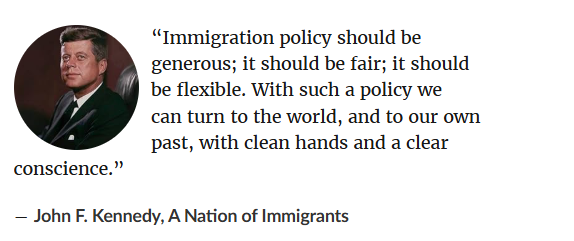
President John F. Kennedy once said,
“Immigration policy should be generous; it should be fair; it should be flexible.”
That clarity still matters today. For staffing firms, aligning the right work model with a candidate’s visa status isn’t just good practice, it’s essential.
The legal side of hiring isn’t optional; it’s your shield. Especially when visas are involved, one wrong move can jeopardize a contract or trigger a costly audit.
Knowing the compliance rules for W2 and C2C models? That’s what keeps you (and your placements) safe.
This is where Consultadd steps in. As the contractor in C2C engagements, we manage all backend administration like contracts, payroll, insurance, 401(k), and relocation support, so staffing firms don’t get overwhelmed by setup or compliance tasks. You focus on facilitating the placement; we take care of the operational heavy lifting.
Work Structure and Lifestyle Considerations
Every candidate brings more than a resume; they bring expectations for how work fits into their life.
Some chase stability. Others crave flexibility. If the structure doesn’t align, they’ll pass fast.
Let’s break down what each employment model means for work style and life balance:
W2 Employment: Predictability and Perks
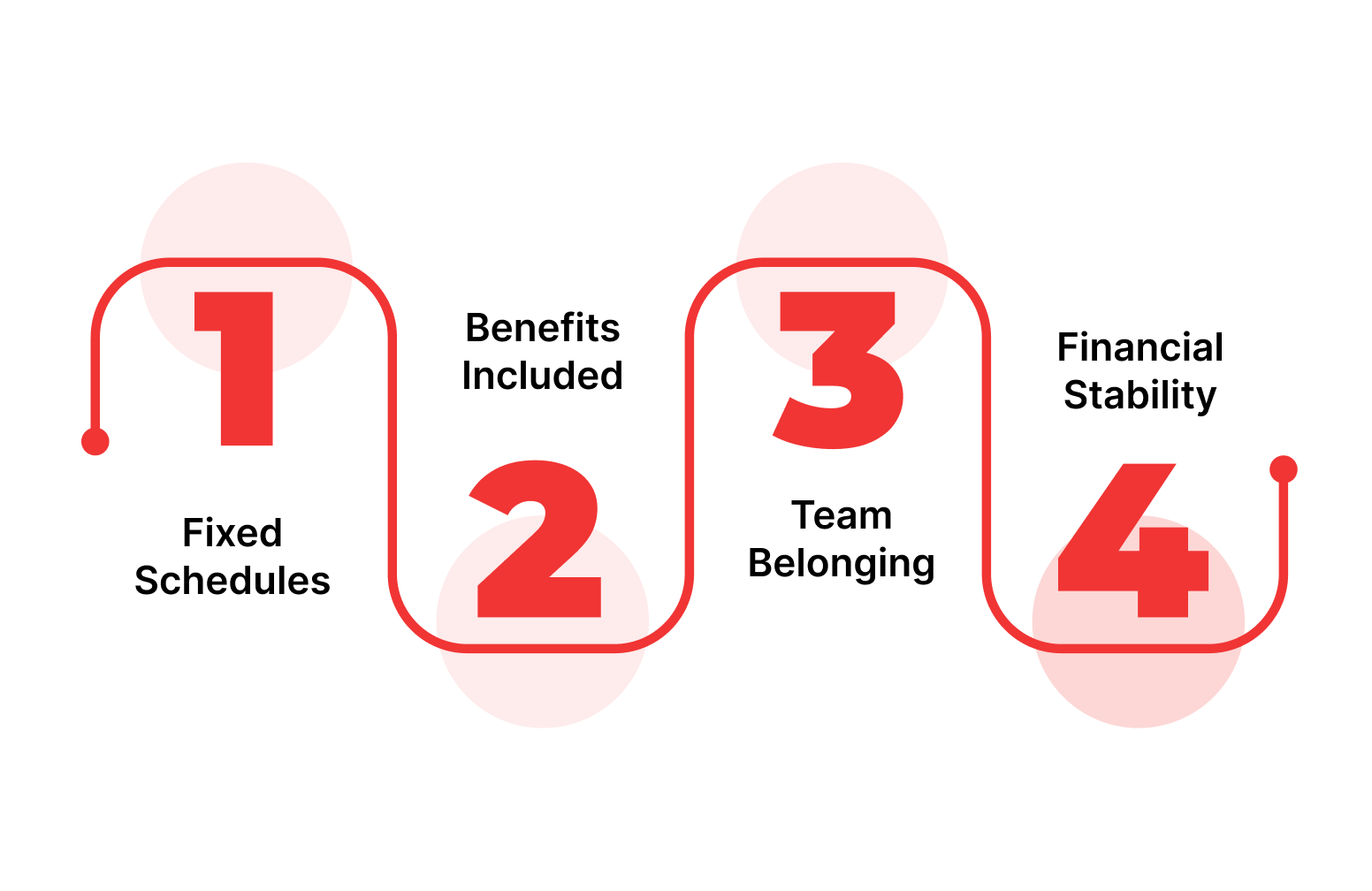
- Fixed Schedules
Set hours offer routine and work-life consistency. - Benefits Included
Health insurance, PTO, and retirement plans add long-term appeal. - Team Belonging
W2 roles often feel more integrated into the company culture. - Financial Stability
Consistent paychecks help reduce personal stress for many professionals.
C2C Engagements: Autonomy with Trade-Offs
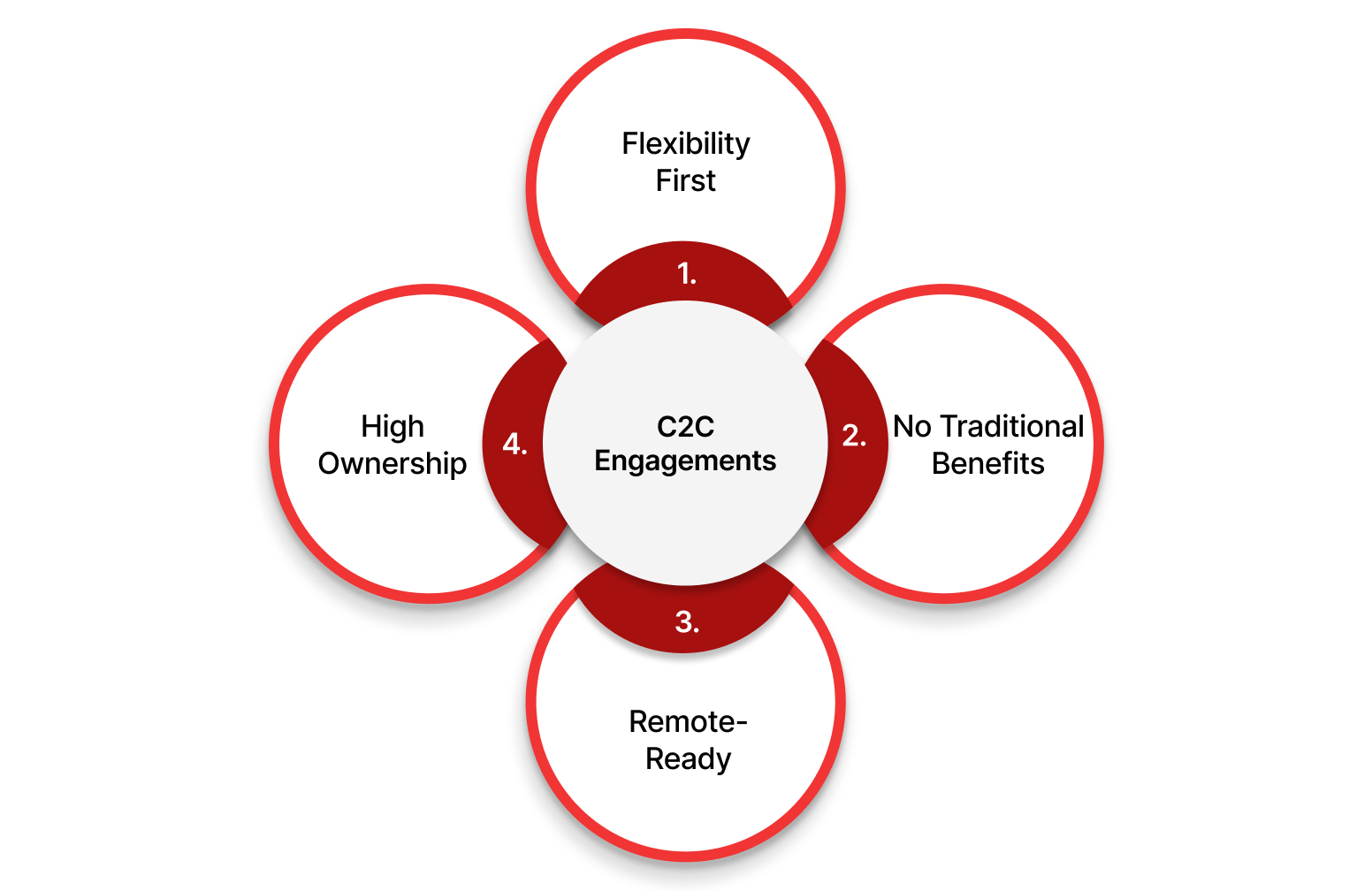
- Flexibility First
Candidates choose their hours, pace, and often their project types. - No Traditional Benefits
Healthcare and taxes? That's on the contractor. - Remote-Ready
C2C roles are often more remote-friendly, ideal for digital nomads or solo workers. - High Ownership
Contractors manage their own corp, taxes, and client relationships.
Administrative Burden and Paperwork
Let’s face it, no hiring manager dreams of spending their day buried in compliance docs and time sheets.
But the model you hire under determines just how deep into the admin spiral you go.
Here’s a side-by-side look at how W2 and C2C stack up on paperwork, reporting, and overall effort:
- W2 – Centralized: More upfront steps, with defined checkpoints and documentation. Heavier at the start, but streamlined by the employer.
- C2C – Distributed: Lighter upfront, but more legal/tax complexity across states or clients. Requires organized handling by the contractor and firm.
- Both Require Precision: Missing forms or delays can stall onboarding. Attention to detail is critical in both models.
In C2C, contractors like Consultadd are responsible for handling tax filings and expenses, reducing your administrative load. With full-service support, we manage all operational details, ensuring compliance and legal concerns are expertly handled.
For hiring managers looking to streamline these processes from the ground up, refining your sourcing and procurement workflow is critical. Learn how to do that efficiently in our blog: The Smart Way to Approach Sourcing & Procurement.
Conclusion: Align Work Model with Immigration and Career Needs
Recruiting today is about making lasting, compliant placements that deliver from day one. With tighter timelines, legal risks, and higher turnover, there's little room for error.
Understanding W2 vs. C2C, tax, and compliance is crucial. C2C offers flexibility and scalability, making it an excellent choice.
That’s where Consultadd steps in. We support through:
- Safe, reliable hires: With 5,000+ staffing engagements completed, we know how to identify real talent and make it stick.
- Low turnover, high trust: Our top 100 candidates last year weren’t just skilled; they were committed.
- Seamless compliance: Visa documentation, state taxes, employment law—we’ve handled it all for 14+ years.
- Fast turnaround: We can source ready-to-deploy talent in under 24 hours.
- Backed by strong relationships: Our MSAs with Robert Half, Teksystems, and 65+ staffing firms prove we deliver.
- 1:1 account managers: Dedicated experts who know your market and reduce your admin workload.
- University-backed talent pipeline: Our academic ties give you early access to emerging tech and business talent.
- Support beyond placement: Because true ROI begins after the hire.
When clients demand precision, speed, and compliance, you need more than a vendor. You need a partner like Consultadd to help you win every time.
Let’s build your next winning team, start your partnership with us today.
